



























PO Box 2372, Cape Town, 8000 Tel: 083 233-1956
www.scross.co.za
A D E R S H I P T E A M: Editor: Günther Simmermacher editor@scross co za
Managing Director: Eugene Jackson md@scross co za

Subscriptions Manager: Pamela Davids subscriptions@scross co za Cell: 071 218-5287






Digital Editor: Claire Allen c allen@scross co za
Features Writer: Daluxolo Moloantoa daluxolo@scross co za
Advisory Editor: Michael Shackleton
ADVERTISING: advertising@scross co za
SUBSCRIPTIONS: subscriptions@scross co za
A n n uA l S u b S c r i p t i o n S:
Print & Digital: R480 (SA); Digital only: R300; Print only: R480 (SA)
Subscribe at www scross co za/subscribe
BOARD OF DIRECTORS:
R Shields (chair), Bishop S Sipuka, Bishop S David OMI (alt), S Duval, E Jackson, B Jordan, C Mathieson, N Mpushe, Fr H O’Connor, R Perrier, D Shikwambana, G Stubbs
become an Associate and help t h E S o u t h E r n c r o S S survive: www.scross.co.za/ associates-campaign/
Advertising ratecard is available from advertising@scross.co.za or download at www.scross.co.za/advertising
OC TO B E R I S M I S S I O N M O N T H , so it is right that in this issue there is a running thread of evangelisation The proclamation of the Good News, in the many forms this can be done, is the ultimate purpose of a Catholic magazine, after all – as it is for the entire Church
Our cover features October ’s “Saint of the Month”, the much-loved Bl Carlo Acutis, the Italian teenager whose mission field was the Internet Through his website on Eucharistic miracles, created in his bedroom in Milan, Carlo reached multitudes all over the world And his mission lives on in the worldwide exhibitions of his work, including in Southern Africa.

Bl Carlo died in 2006, before the rapid rise of social media; but we can be certain that he would have used the various digital platforms available to us now to great effect
The mission field “Digital World” has great reach, but most Church leaders still have no clear idea of how to use it This is where the bishops’ new communications manager, Sheila Pires whom we feature on page 8 has her work cut out: to conscientise the clergy and laity, and especially the bishops, about evangelising by using the various available media, such as digital, broadcast and print, both Catholic and secular
There are some excellent examples in Southern Africa to show how media can be used well in the ser vice of our Church, but generally, its potential remains dismally unexplored and unappreciated
But should we, the faithful, wait for bishops and clergy to get their communications act together? All of us are called to be missionaries with the necessar y caveat that, in our digital evangelisation efforts, we must beware of causing people to lose faith or of becoming obstacles to people finding the Church
These concerns will doubtless be discussed at the Synod on Synodality. The title of this assembly is unappealingly technical, but it concerns all of us, since the Synod’s outcomes will shape the future of our Church in many ways
That future calls us today to find creative solutions to the growing sense
of apathy, hopelessness and alienation felt by so many people, including and especially the youth, in the rapidly secularising Western society a development from which South Africa is not immune. We will need to reach these people to communicate the joy of our faith, and the peace of walking with the Lord.
There will be many ways of doing so there is no single answer to appealing to young people, as though the youth were some homogeneous monolith At the centre of all the possible approaches must always be the love and mercy of the Lord for all his Creation, even those whose lives don’t always conform with the doctrines of the Church
There is a lot of woundedness in the world, and Pope Francis’ metaphor of the Church as a field hospital must be a central theme as we look to the future, as the Synod will be doing this month
In this issue, we inter view Jesuit Father Anthony Egan on the Synod and its process, which will continue until October 2024, and likely be followed by a papal apostolic exhortation
But as Fr Egan sug gests, the synodal process does not end when the 2024 assembly disperses or the pope issues his document It is an ongoing development which will require closer collaboration and dialogue between bishops, clergy, religious and the laity It will ask of the laity greater involvement in running the Church and this will become increasingly necessar y as the numbers of priests decline and demand an openness by bishops and clergy to involve the laity in concrete decision-making
In this way, the Synod on Synodality concerns us all, and it must not be ignored. It will define how we will evangelise in the future and that is indeed a question of mission!
Thank you for reading The Southern Cross, and please tell your friends about your monthly Catholic magazine God bless,
Günther Simmermacher (Editor)O CTOBER 2023
8 Bishops’ media woman on her mission

10
13

Sheila Pires on her mission as the new SACBC communications manager and her role at the Synod
Synod on Synodality: What it means
We interview Fr Anthony Egan SJ on the Synod: what it is, and where it may lead
How ex-SA priest survived visa limbo
A priest who previously served in KZN turned waiting for a US work visa into an advantage
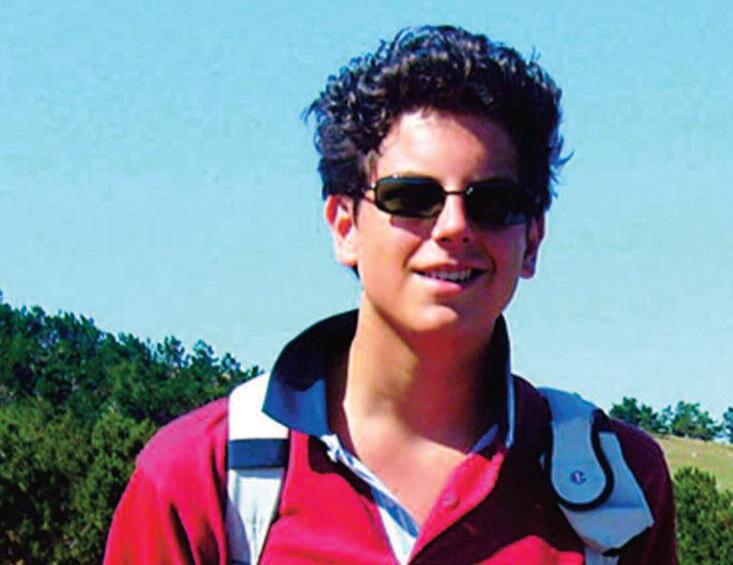
14 Mont St Michel’s first thousand years
16
21
We look back at the first 1 000 years of one of the world’s most famous monasteries
Book of praises for Fr Albert Nolan
We review a book of tributes to the late Dominican Father Albert Nolan
Triplets in one religious order
In Brazil, an order has triplets among its Sisters
22 Heroes in the Namaqualand
How ordinary rural people do extraordinary things with the help of a Catholic NGO
24
Holy Wins to offset Halloween
Halloween glorifies things that are dark, but there is a Catholic alternative to bring light

EVERY MONTH
5 FROM OUR VAULTS
The Southern Cross 94 years ago
6 YOUR QUESTIONS ANSWERED
We answer your questions about married priests, extra books in the Bible, and chewing gum at Mass 17 SAINT OF THE MONTH
The life of Bl Carlo Acutis with pull-out poster
LETTERS TO THE EDITOR
Have your say!
POINT OF REFLECTION
Fr Xolile Galata SDB on his vocation
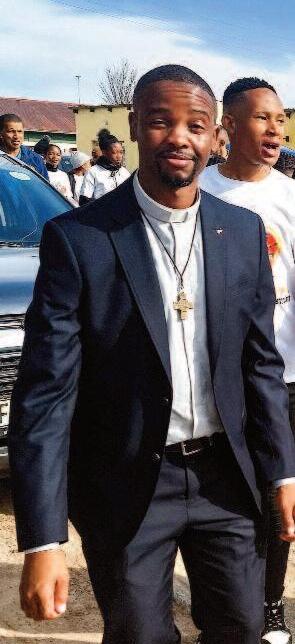
Mariannhill monaster y, near Durban, welcomed a distinguished guest when the Earl of Athlone, governor-general of South Africa, made a private visit He was shown ever ything of interest by Mariannhill provincial Fr Ludyer and Br Tintau It was the earl’s special pleasure to meet the old missionar y pioneers in their different workshops

B a r g a i n s a s b o o k s h o p m o v e s Bargains are to be had in a sale as the Catholic Repositor y in Cape Town is moving from its premises at 20 St George’s Street, which has been sold to Kinemas Ltd, to the Salesian Institute in Somerset Road Prayer books, wall plaques and white plaster statues are going for up to half price

K i m b e r l e y p i o n e e r d i e s Aloysius Harrison, an early settler in Kimberley, died on October 26 after a long illness He will be remembered as a staunch supporter of the Catholic Church and its charities


C h e s t e r t o n h a i l s D o m i n i c a n
I n a n a r t i c l e , G K C h e s t e r t o n h a i l s p r o m i n e n t E n g l i s h D o m i n i c a n F a t h e r Vi n c e n t M c N a b b a s “ o n e o f t h e f r e e g r e a t m e n o f o u r t i m e I i n f o r m h i m o f t h i s f a c t w i t h t h e g r e a t e r c o n f i d e n c e a n d f i r m n e s s , b e c a u s e I k n o w h e i s m u c h t o o g r e a t t o b e l i e v e i t ”
P r e v i o u s “ F r o m T h e Va u l t s ” a r t i c l e s a t w w w s c r o s s c o z a / v a u l t s



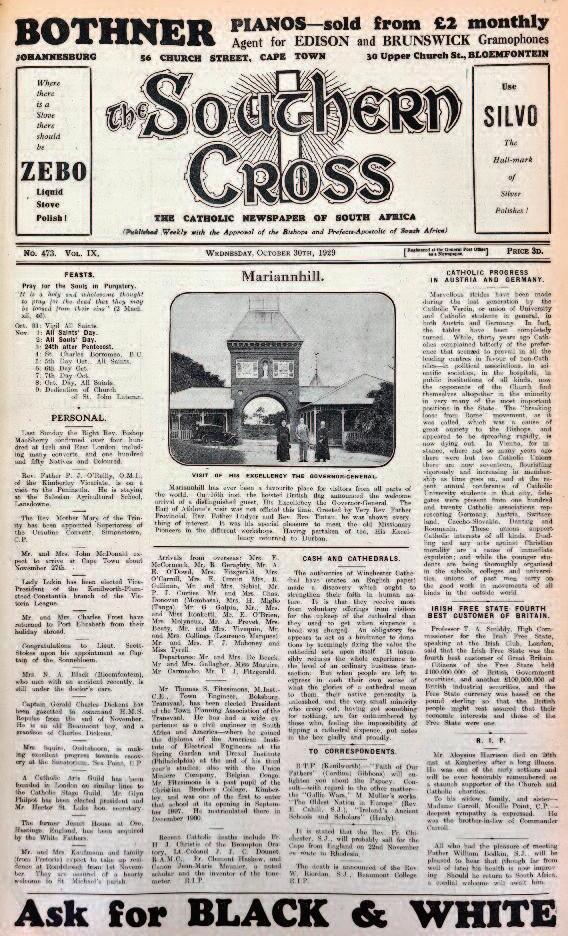
• On October 29, the US stock market crashes in an event known as Black Tuesday, leading to the global Great Depression.
• Corrupt South African business magnate and politician Sir Joseph Robinson, who illicitly bought himself a peerage from British prime minister David Lloyd George, dies on October 30 at the age of 89.
• The Kingdom of Serbs, Croats and Slovenes changes its name to the Kingdom of Yugoslavia
• France’s government under Aristide Briand falls, over his policy to demilitarise the Rhineland.
German foreign minister Gustav Stresemann, with whom Briand had won the Nobel Peace Prize in 1926, died suddenly a few weeks earlier at the age of 51, on October 3
Q According to our parish priest, “some priests in the Catholic Church can get married, it depends which rite of the Catholic Church they belong to”. I have never heard of this. Could you elaborate?


YOUR PRIEST IS CORRECT AS you know, there are several rites within the Church, of which the Latin (or Roman) rite is the most common one But there are other rites that have their origins in the ancient Christian traditions of the Eastern churches They are in communion with the pope and acknowledge the authority of the universal Catholic Church
However, most Eastern Christian communities have preserved their unique liturgical, theological, and spiritual traditions. They retain their distinct liturgical practices, and often have their own hierarchy and canon law, while still remaining in full communion with Rome


These rites include Maronite, Melkite, Chaldean, Greek, Armenian, Coptic, Ukrainian, Ruthenian, Russian, Syro-Malabar, and so on
Some of these rites’ traditions and
practices are older than those in the Latin rite For example, the discipline of obligatory celibacy for priests was universally formalised for the Latin rite only in the 11th century

Several Eastern Catholic rites allow for married priests. However, not all Eastern rites do For example, the Syro-Malabar Catholic Church in India, which follows the East Syriac liturgical tradition, requires its priests to be celibate and unmarried
I S C H E W I N G G U M A T M A S S A L L O W E D ?
Q I h a v e n o t i c e d t h a t t h e re a re s o m e p e o p l e c h e w i n g b u b b l e g u m d u r i n g M a s s , a n d I h a v e e v e n s e e n p e o p l e c o m i n g u p t o re c e i v e C o mm u n i o n w h i l e s t i l l c h e w i n g t h e i r g u m . S h o u l d t h e p r i e s t o r e x t r ao rd i n a r y m i n i s t e r o f t h e E u c h a r i s t re f u s e t o g i v e t h e m C o m m u n i o n ?
CANON LAW TELLS CATHOLICS t h a t t h e y a r e t o a b s t a i n f r o m a l l f o o d a n d d r i n k w i t h t h e e x c e p t i o n o f w a t e r o r m e d i c a t i o n f o r a t l e a s t o n e h o u r b e f o r e r e c e i v i n g C o m m u n i o n
( 9 1 9 . 1 ) . T h e r e a s o n i s t o r e m i n d u s h o w s p e c i a l t h e E u c h a r i s t i s , n o u r i s h i n g u s f o r l i f e e t e r n a l H o w e v e r , n o w h e r e d o e s c a n o n l a w d e f i n e p r e c i s e l y w h a t c o n s t i t u t e s f o o d a n d w h a t d o e s n o t

But even those rites that allow married priests have certain requirements and limitations Prospective priests must be already married before they seek ordination and receive special permission from the local bishop Once ordained, they may not marry And married priests are precluded from becoming bishops.
Even in the Latin rite there are some married priests These are married clergy who were previously ordained in another Christian tradition and subsequently converted to Catholicism. This practice is known as the “pastoral provision” or “ordinariate”, and allows for the ordination as Catholic priests of married former Protestant ministers, particularly Anglicans who have become Catholic
S o m e p e o p l e m i g h t s u g g e s t t h a t s i n c e s u g a r - f r e e c h e w i n g g u m h a s n o n u t r i t i o n a l v a l u e , i t d o e s n o t q u a l i f y a s f o o d T h i s m a y b e s o , b u t o n e m a y l e g i t i m a t e l y a r g u e t h a t c h e w i n g g u m o f a n y k i n d , w h e n c o n s u m e d d u r i n g t h e M a s s , p r o f a n e s t h e m o u t h a s a p r o p e r r e c e p t o r f o r C o m m u n i o n a n d s h o u l d t h e r e f o r e b e a v o i d e d
A s f o r w i t h h o l d i n g C o m m u n i o n w h e n y o u n g g u m - c h e w e r s p r e s e n t t h e m s e l v e s t o r e c e i v e t h e B o d y o f C h r i s t , m o s t p r i e s t s w i l l p r o b a b l y t a k e t h e v i e w t h a t i t i s b e t t e r n o t t o p u b l i c l y e m b a r r a s s t h a t p e r s o n I n a n y c a s e , w e d o n o t k n o w w h e t h e r t h e r e m a y b e a g o o d ( e v e n i f u n u s u a l ) m e d i c a l r e a s o n f o r t h a t p e r s o n t o b e c h e w i n g g u m
W h y n o t i n s t e a d s e e k t h a t p e r s o n o u t a f t e r M a s s a n d t a l k w i t h t h e m a s t o t h e a p p r o p r i a t e n e s s o f c h e w i n g g u m b e f o r e r e c e i v i n g
C o m m u n i o n ? A n d i f t h e p r o b l e m i s c o m m o n i n y o u r p a r i s h , p e r h a p s a n o c c a s i o n a l r e m i n d e r i n t h e c h u r c h
n e w s l e t t e r o r p a r i s h n o t i c e s m i g h t h e l p
Q . W h y d o e s t h e C a t h o l i c B i b l e h a v e m o re b o o k s t h a n t h e re a re i n t h e P ro t e s t a n t B i b l e ?
CATHOLIC AND PROTESTANT

Bibles both have the same 27 books in the New Testament
The difference in the number of books between the respective Bibles is primarily due to a collection of Old Testament writings known as the Deuterocanonical books (the word can be translated as “second canon”), which are included in the Catholic Bible but not in the Protestant Bible In Protestant terminology, these books are termed “Apocrypha”
Both Bibles contain the Hebrew Bible, also known as the Tanakh, which consists of three main sections: the Torah (the five books of Moses), the Nevi’im (the Prophets), and the Ketuvim (the Writings). This collection of books is accepted as complete by both Jews and Protestants
The Catholic Bible, however, includes additional books and passages that are considered part of the Old Testament. These additional books are Tobit, Judith, Wisdom of Solomon, Sirach (or Ecclesiasticus), Baruch, and First and Second Maccabees The Catholic Bible also includes additional portions in the books of Esther and Daniel
The inclusion of the Deuterocanonical books in the Catholic Bible
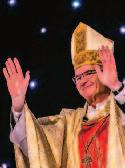



has historical roots These books were widely accepted as part of the Old Testament in early Christianity, and they were included in the Septuagint, the Greek translation of the Hebrew Scriptures in the 3rd century BC that was commonly used by Jews and early Christians D


However, many early Church leaders considered these additional books as edifying but not authoritative for doctrine So there were two schools of thought: those (such as Origen or Cyril of Jerusalem) who believed that the Scripture should include only canonical books which established doctrine for the Church, and those (such as St Augustine or Pope Innocent I) who held that books
should be included in the canon if they were read in churches



T h e D e u t e r o -
c a n o n i c a l b o o k s
w e r e i n c l u d e d i n
t h e V u l g a t e , t h e
f i r s t t r a n s l a t i o n o f
t h e B i b l e i n t o L a t i n
b y S t J e r o m e i n t h e
4 t h c e n t u r y , b u t h e s t i l l a s s i g n e d t o t h e m a s e c o n d a r y s t a t u s .
D i s a g r e e m e n t s c o n t i n u e d f o r m o r e t h a n a t h o u s a n d y e a r s , e v e n w h e n t h e P r o t e s t a n t R e f o r m a t i o n b r o k e o u t i n t h e 1 6 t h c e n t u r y S o m e P r o t e s t a n t r e f o r m e r s , b a s e d o n t h e i r i n t e r p r e t at i o n o f H e b r e w t e x t s a n d t h e i r u n d e r s t a n d i n g o f d o c t r i n a l m a t t e r s ( p a r t i c u l a r l y i n t h e b o o k s o f T o b i t a n d 2 M a c c a b e e s ) , c h o s e t o e x c l u d e t h e D e u t e r o c a n o n i c a l b o o k s f r o m t h e i r v e r s i o n o f t h e B i b l e
T h e C o u n c i l o f T r e n t , c a l l e d b y t h e C a t h o l i c C h u r c h f r o m 1 5 4 5 - 6 3 t o r e s p o n d t o t h e R e f o r m a t i o n , c o n f i r m e d t h e i n c l u s i o n o f t h e D e u t e r o c a n o n i c a l b o o k s
I n c i d e n t a l l y , E a s t e r n O r t h o d o x B i b l e s i n c l u d e n o t o n l y t h e D e u t e r oc a n o n i c a l b o o k s b u t a l s o s e v e r a l b o o k s a n d t e x t s t h a t a r e r e j e c t e d a s c a n o n i c a l b y b o t h C a t h o l i c s a n d P r o t e s t a n t s
Back copies are available at R20 plus p&p. Simply place your order with admin@scross.co.za

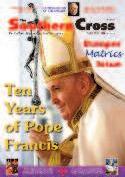

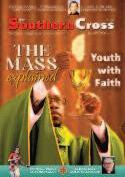

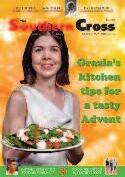


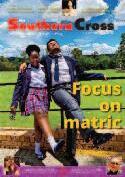
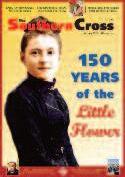


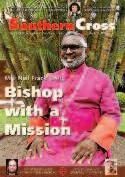
Catch up with Saint of the Month posters: St Teresa of Avila; St Martin de Porres; St John Bosco; St Josephine Bakhita; St Charles Lwanga; St John Vianney; St Vincent de Paul; St John XXIII, St Oscar Romero, St Bernadette, St Anthony of Padua, St Anne, St Joseph, St Elizabeth, St Maximilian Kolbe, St Teresa of Kolkata, St Francis of Assisi, St Nicholas, St Catherine of Siena, St Ignatius, St Clare and more
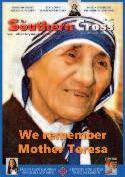
After almost two decades with Radio Veritas, Sheila Pires now leads the bishops’ media office and has been appointed to a key position at the Synod for Synodality. She spoke to Daluxolo Moloantoa

TO S P R E A D T H E G O S P E L T O T H E P E O P L E O F G O D t h r o u g h t h e m e d i a t h a t i s t h e p e r s o n a l m i s s i o n s t a t e m e n t w h i c h S h e i l a P i r e s s e t f o r h e r s e l f w h e n s t a r t i n g o u t i n h e r c a r e e r a s a C a t h o l i c m e d i a p r o f e s s i o n a l . N i n e t e e n y e a r s l a t e r, s h e i s s t i l l f o c u s e d o n h e r m i s s i o n , a l b e i t t h r o u g h v a r i o u s p l a t f o r m s o v e r t h e y e a r s , a n d i n d e e d w e l l b e y o n d t h e c o n f i n e s o f t h e S o u t h e r n A f r i c a n C h u rc h
I n A u g u s t 2 0 2 1 , s h e w a s t h e s u b j e c t o f a S o u t h e r n C ro s s f e a t u r e A t t h e t i m e , s h e w a s a p r e s e n t e r a n d p r o d u c e r a t R a d i o Ve r i t a s S i n c e t h e n , a l o t h a s h a p p e n e d T h i s y e a r s h e w a s a p p o i n t e d c o m m u n i c a t i o n s m a n a g e r o f t h e S o u t h e r n A f r i c a n C a t h o l i c B i s h o p s ’ C o n f e r e n c e ( S A C B C ) , t h e f i r s t l a y p e r s o n t o h e a d t h e o f f i c e i n m a n y y e a r s .
A n d t h i s m o n t h , S h e i l a w i l l s e r v e a s t h e s e c r e t a r y o f t h e C o m m i t t e e f o r I n f o r m a t i o n o f t h e S y n o d o n S y n o d a l i t y T h e m a i n t a s k o f t h e s e c r e t a r y i s t o h e l p s h a p e t h e i n f o r m a t i o n w h i c h t h e a s s e m b l y w a n t s t o s h a r e , a n d t o o v e r s e e a l l t h e m e d i a o p e r a t i o n s H e r a p p o i n t m e n t i s n o t o n l y a p e r s o n a l v a l i d a t i o n b u t a l s o a f e a t h e r i n t h e c a p o f t h e S o u t h e r n A f r i c a n C h u rc h B o r n i n X a i - X a i , i n t h e s o u t h e r n M o z a m b i q u e p r o v i n c e o f G a z a , S h e i l a i s o n e o f f i v e s i b l i n g s , t h r e e s i s t e r s a n d a b r o t h e r. H e r m a t e r n a l f a m i l y ’s C a t h o l i c p i e t y h a s p r o d u c e d a b i s h o p , a p r i e s t a n d t w o n u n s
C a r d i n a l J u l i o D u a r t e L a n g a , e m e r i t u s b i s h o p o f X a i - X a i , i s h e r g r e a t - u n c l e
A l m o s t 2 0 y e a r s a t R a d i o V e r i t a s S h e i l a s t a r t e d h e r m e d i a c a r e e r a l m o s t t w o d e c a d e s a g o a t R a d i o Ve r i t a s T h i s i s w h e r e s h e d e v e l o p e d a n d h o n e d h e r s k i l l s a s a r a d i o s h o w p r o d u c e r, r e s e a rc h e r, e d i t o r a n d p r e s e n t e r B e f o r e t h i s , s h e a t t e n d e d R a d i o
M o z a m b i q u e M u s i c S c h o o l i n M a p u t o S h e w a s a l s o a m e m b e r o f t h e R a d i o M o z a m b i q u e O rc h e s t r a , w h e r e s h e p l a y e d t h e b a s s m e l o d i c a a s a n e i g h t - y e a r o l d
“ I t h a s b e e n 1 9 y e a r s o f g r o w t h , b o t h p r o f e s s i o n a l l y a n d a s a n i n d i v i d u a l I s t a r t e d w o r k i n g a t R a d i o Ve r i t a s w h e n I w a s i n m y e a r l y t w e n t i e s . I l e a r n e d t o l o v e a n d b e p a s s i o n a t e a b o u t m y w o r k a s i t w a s n ’t a b o u t m e b u t a b o u t s p r e a d i n g t h e G o s p e l t o t h e P e o p l e o f G o d t h r o u g h t h e a i r w a v e s , ” s h e t o l d T h e S o u t h e r n C ro s s
H e r p a s s i o n e n t a i l e d e q u i p p i n g h e r s e l f w i t h a n o p e n m i n d a n d n e w i d e a s t o a d v a n c e h e r s p e c i a l i s a t i o n i n t h e C a t h o l i c m e d i a l a n d s c a p e H a v i n g a l w a y s b e e n i n t e r e s t e d i n p o l i t i c s , w o m e n ’s i s s u e s a n d s o c i a l j u s t i c e , s h e d e v e l o p e d t h e i d e a o f t a l k i n g a b o u t t h e s e i s s u e s f r o m a C a t h o l i c p e r s p e c t i v e .
“ W h i l e a t R a d i o Ve r i t a s , I c a m e u p w i t h t h e i d e a f o r a s o c i o - p o l i t i c a l r a d i o p r o g r a m m e c a l l e d ‘ C a t h o l i c Vi e w ’ I t w a s a C a t h o l i c c u r r e n t a f f a i r s p r o g r a m m e w h i c h l o o k e d i n t o p r e s e n t i s s u e s t h r o u g h C a t h o l i c e y e s I w o u l d i n v i t e v a r i o u s g u e s t s t o t a l k a b o u t t h e s e t o p i c s , a n d t o d i s s e c t t h e s e a l o n g s i d e t h e i r i n t e r p r e t a t i o n i n C a t h o l i c S o c i a l Te a c h i n g s T h e p r o g r a m m e w a s i n s p i r e d b y t h e e v e n i n g p r o g r a m m e s o f w h a t w a s t h e n Va t i c a n R a d i o , ” s h e s a i d . S h e i l a w e n t o n t o i n t r o d u c e a n u m b e r o f o t h e r s h o w s a t t h e J o h a n n e s b u r g - b a s e d s t a t i o n O n e w a s a p r o g r a m m e t o l o o k a t w o m e n ’s i s s u e s s p e c i f i c a l l y. “ I n 2 0 2 2 I d e c i d e d t o s t a r t a n o t h e r f e a t u r e p r o g r a m m e , d e d i c a t e d t o b o y s I f e l t t h a t w e c o u l d n o t e m p o w e r w o m e n a n d g i r l s a n d l e a v e t h e b o y c h i l d b e h i n d T h e y t o o n e e d e d a s p a c e w h e r e t h e y c o u l d a d d r e s s m a t t e r s o f c o n c e r n , g r o w t h , r e s p e c t f o r w o m e n a n d g i r l s a n d s o o n B u t a b o v e a l l , i t w a s a s p a c e f o r b o y s t o t a l k a n d s h a r e t h e i r l i f e e x p e r i e n c e s , ” s h e s a i d
A s u r p r i s e a p p o i n t m e n t
I n M a rc h t h i s y e a r s h e b a d e g o o d b y e t o R a d i o Ve r i t a s a n d t o o k u p t h e p o s i t i o n o f t h e S A C B C ’s c o m m u n i c a t i o n s m a n a g e r. N e w s o f t h e b i s h o p s ’ d e c i s i o n t o a p p o i n t S h e i l a w a s b r o k e n t o h e r b y t h e S A C B C l i a i s o n b i s h o p f o r c o mm u n i c a t i o n s , C a r d i n a l S t e p h e n B r i s l i n , a n d S A C B C s e c r e t a r y - g e n e r a l F r H u g h O ’ C o n n o r “ I t r e a l l y c a m e a s a s u r p r i s e b e c a u s e I a l w a y s t h o u g h t t h a t t h e p o s i t i o n w a s o n l y f o r t h e c l e r g y o r r e l i g i o u s w o m e n A l t h o u g h i t w a s d i f f i c u l t t o l e a v e R a d i o Ve r i t a s , I f e l t i t w a s G o d ’s w i l l t h a t I s h a r e m y e x p e r i e n c e a n d e x p e r t i s e e l s e w h e r e w i t h i n t h e b o d y o f t h e C h u rc h , n o w a t t h e S A C B C , ” s h e s a i d I n h e r f i r s t s i x m o n t h s a s c o m m u n i c a t i o n s m a n a g e r, S h e i l a h a s i m p l e m e n t e d n e w i d e a s . “ I h a v e b r o u g h t t h e j o u r n a l i s t ’s a p p r o a c h i n r e p o r t i n g , m o r e u s e o f s o c i a l m e d i a p l a t f o r m s , a n d m o r e u s e o f t h e S A C B C Yo u Tu b e c h a n n e l I ’ v e a l s o p u t m o r e e f f o r t i n t o s h a r i n g o u r n e w s a n d e v e n t s w i t h o u r S o u t h e r n A f r i c a n s e c u l a r m e d i a a n d w i t h b o t h t h e A f r i c a n C a t h o l i c m e d i a a n d w i t h Va t i c a n N e w s , ” s h e e x p l a i n e d
I am grateful for the inclusion of women from the global south
T h e S o u t h e r n A f r i c a n b i s h o p s ’ a d l i m i n a v i s i t t o R o m e i n J u n e s e r v e d a s a g r e a t p l a t f o r m t o i m p l e m e n t t h e n e w w a y o f r e p o r t i n g . “ T h e v i s i t w a s a s u c c e s s f r o m a m e d i a c o v e r a g e p o i n t o f v i e w, a s w e e n s u r e d t h a t C a t h o l i c s i n t h e S A C B C r e g i o n a n d w o r l d w i d e w e r e a b l e t o f o l l o w t h e e v e n t s a r o u n d t h e v i s i t o n a d a i l y b a s i s O v e r t h e y e a r s I h a v e b u i l t r e l a t i o n s w i t h s e v e r a l
C a t h o l i c a n d s e c u l a r m e d i a , w h i c h a l s o h e l p e d t o p u b l i c i s e t h e b i s h o p s ’ v i s i t , ” s h e s a i d
I n A p r i l t h i s y e a r, t h e S y m p o s i u m o f E p i s c o p a l C o n f e r e n c e s o f A f r i c a a n d M a d a g a s c a r ( S E C A M ) a p p o i n t e d S h e i l a a m e m b e r o f t h e g o l d e n j u b i l e e p l a n n i n g c o m m i tt e e o f t h e P a n A f r i c a n E p i s c o p a l C o m m i t t e e f o r S o c i a l
C o m m u n i c a t i o n s S h e u s e s t h i s p l a t f o r m t o s h a r e S A C B C c o n t e n t a n d t o e n s u r e t h a t t h e S A C B C a n d t h e C h u rc h i n S o u t h e r n A f r i c a i s r e c o g n i s e d a n d g i v e n a p r o m i n e n t r o l e w i t h i n C a t h o l i c e v e n t s a t t h e A f r i c a n l e v e l
P o p e h e a r d v o i c e s o f w o m e n
I n 2 0 1 8 , S h e i l a w a s o n e o f t w o S o u t h e r n A f r i c a n w o m e n w h o a t t e n d e d t h e “ C a t h o l i c Wo m e n S p e a k ” s e m i n a r i n R o m e , a l o n g s i d e P r o f N o n t a n d o H a d e b e . T h e i n t e r n a t i o n a l C a t h o l i c w o m e n ’s g a t h e r i n g w a s h e l d t o a d d a v o i c e f o r t h e i n c l u s i o n o f w o m e n i n C h u rc h l e a d e r s h i p r o l e s , a n d f o r r e l i g i o u s a n d l a y w o m e n t o h a v e a r i g h t t o v o t e a t t h e S y n o d o f B i s h o p s . “ P o p e F r a n c i s h a s d o n e e x a c t l y t h a t We h a v e m o r e w o m e n i n p r o m i n e n t r o l e s w i t h i n t h e Va t i c a n A l s o , l a y p e o p l e m e n , w o m e n a n d y o u t h w i l l h a v e t h e r i g h t t o v o t e a t t h e S y n o d o f B i s h o p s o n S y n o d a l i t y, ” s h e n o t e d
“ I a m h a p p y, a n d I a m g r a t e f u l t o G o d a n d t o P o p e F r a n c i s f o r t h i s m i l e s t o n e . B u t a b o v e a l l , I a m g r a t e f u l f o r t h e i n c l u s i o n o f w o m e n f r o m t h e g l o b a l s o u t h , f r o m A f r i c a , a n d f r o m S o u t h e r n A f r i c a i n p a r t i c u l a r ”
T h e w o r k l o a d i s d e f i n i t e l y g r e a t e r a t t h e S A C B C t h a n a n y w h e r e e l s e i n t h e s c o p e o f h e r w o r k . “ I a m s t i l l i n t h e p r o c e s s o f k n o w i n g o t h e r c o m m u n i c a t i o n s o f f i c e r s a t t h e d i o c e s a n l e v e l I a m a l s o i n t h e p r o c e s s o f b u i l d i n g
a n d s t r e n g t h e n i n g r e l a t i o n s w i t h o t h e r C a t h o l i c a n d s e c u l a r m e d i a , a n d c o m m u n i c a t i o n b e t w e e n t h e o f f i c e a n d o t h e r d e p a r t m e n t s w i t h i n t h e S A C B C , ” s h e s a i d
I n t h e l o n g r u n , h e r a i m s w i t h i n t h e S A C B C o f f i c e i n c l u d e s e n s u r i n g t h a t e a c h d i o c e s e h a s a c o m m u n i c at i o n s o f f i c e r ; t o g e t t h e m e d i a c o n s u l t o r s t e a m s g o i n g ; t o
p e w s a r e w e l l - i n f o r m e d ; t o s t r e n g t h e n r e l a t i o n s w i t h C a t h o l i c a n d s e c u l a r m e d i a b o t h l o c a l l y a n d i n t e r n a t i o na l l y ; t o f a c i l i t a t e m e d i a w o r k s h o p s f o r y o u n g C a t h o l i c s ; a n d t o e n c o u r a g e o u r y o u t h t o e m b r a c e a n d l o v e t h e i r C a t h o l i c m e d i a
“ F o r n o w, t h o s e a r e t h e p r i o r i t i e s O n c e w e h a v e
t h i s e s t a b l i s h e d , t h e n t o g e t h e r, a s t h e S o u t h e r n A f r i c a n C h u rc h a n d a s t h e p e o p l e o f G o d i n o u r r e g i o n , w e c a n g r o w, ” S h e i l a c o n c l u d e d
DO YOU KNOW ABOUT OUR ASSOCIATES CAMPAIGN?
This campaign was started to give our readers a way to partner with us in the Catholic media apostolate and outreach. Our associates form a loyal body who contribute to us annually.



• Receive a free digital or print subscription if you donate R200 or more per month. • As an Associate, Holy Mass for your intention is celebrated twice a year.
• You will receive regular updates on the campaign.
Sign up online and select R1200, R2400, R3000 or R5000 annual contribution or contribute any amount via EFT
The Southern Cross Std Bank Thibault Square, Branch code: 020909, Savings account no: 276 876 016. Use “Associates/Surname” as the reference. Please let us know you have signed up! email associates@scross.co.zaor admin@scross.co.za
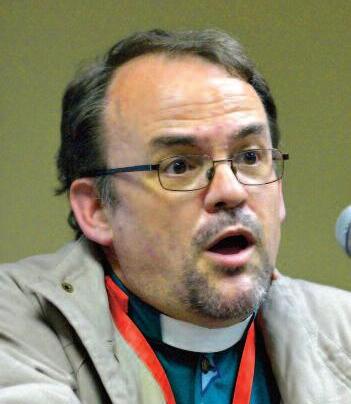

After two years of preparation and unprecedented global consultation, the first round of the Synod on Synodality will take place from October 4-29 We interviewed theologian and historian Fr Anthony Egan SJ to explain the synod, what it means and how it will impact on the Church.
T h e S o u t h e r n C r o s s : I n s i m p l e t e r m s , w i s a s y n o d ?
F r A n t h o n y E g a n S J : I n s i m p l e s t t e r m s , t h a s s e m b l y i n O c t o b e r w i l l b e t h e 1 6 t h O r d i n a r y G e n e r a l A s s e m b l y o f t h e S y n o d o f B i s h o p s , r o o t e d i n a p r a c t i c e o f t h e a nc i e n t C h u r c h t h a t w a s r e - e s t a b l i s h e d b y t h e S e c o n d Va t i c a n C o u n c i l .
A synod of bishops is defined in Canon 3 4 2 o f t h e 1 9 8 3 C o d e o f C a n o n L a w a s “ group of bishops who have been chosen fro different regions of the world and meet at fi t i m e s t o f o s t e r c l o s e r u n i t y b e t w e e n t h e R pontiff and bishops, to assist the Roman pon their counsel in the preser vation and growth of faith and morals and in the obser vance and strengthening of ecclesiastical discipline, and to consider questions pertaining to the activity of the Church in the world”
If I may break down this lengthy statement, this means that the gathering is an expression not the only one of the collegial role of bishops with the pope, and never witho u t h i m , i n e x e rc i s i n g u n i t e d theological, moral and pastoral leadership in the Church
Although ultimately advisory, the decisions of past episcopal synods have had significant impact on the administration and theological direction of the Church. This includes things like the creation of the International Theological Commission and the 1983 Revised Code of Canon Law, as well as significant papal apostolic exhortations on theological questions, such as Evangeli nuntiandi (1975) on evangelisation, and Amoris laetitia (2016) on mar-
The Synod on Synodality, initiated by Pope Francis in October 2021, is a multi-year, worldwide undertaking during which Catholics and even those who are not were asked to submit feedback to their local dioceses on questions of their and the Church’s concerns
The massive synodal process has already undergone diocesan, national and continental stages, and will culminate in two global assemblies at the Vatican The first will take place in October this year
e and family, to name but two.
Why has Pope Francis called a “Synod of ynodality” specifically?
The present synod has the theme “For a synodal Church: communion, participation and mission” This sums up why Pope Francis has called it: his desire for a more collegial and consultative Church that takes seriously the charismatic gifts of all its members
It reflects his real concern about too uch clerical domination in the Church, pararly from the centre and top the Vatican wards and downwards This has not been the practice of the Church for much of its history, and in many ways has created a standardised, homogenised and Europe-centred institution that has taken little notion of the diverse cultural expressions of the faith in the rest of the world Vatican II tried to address that, but in many aspects somehow got stalled along the way
I suspect too that the three interconnected themes communion, participation, mission are echoes of the need he feels to renew the Church in the wake of the abuse crisis, where the Church’s mission has been compromised, where religious participation has been damaged, and the sense of trust in and connectedness to clergy and bishops has taken a severe knock in many countries.
How does this synod differ from synods in the past?
Firstly, the synodal process that has led up to it is quite new. Not in the sense that synods happened without prior discus-
On June 20, the Vatican issued a working document called the Instrumentum Laboris to guide the discussions at the first global assembly of the Synod on Synodality It contains 15 worksheets with questions for discernment for delegates Written by a committee of 22 people, it has been presented as a synthesis of the eight final documents produced by the continental assemblies that met in the first months of 2023
The main objective of this year’s session will be to design a plan of study in a “synodal style”. Discernment will be “completed” in the 2024 session of the synod The pope will then likely produce an apostolic exhortation based on the deliberations and decisions of the synod
The process is intended to be guided by the Holy Spirit Pope Francis has said that he called for the Synod on Synodality to “place the Holy Spirit at the beginning and at the heart of the work of the synod”
‘For the first time since the early Church, lay people have the same voting rights as bishops’
sions and consultations, they did; but in this case it is the extent of the consultation, extended to as many people in the Church as possible. I don’t think such consultation has happened since the early Church, perhaps since the Council of Jerusalem as recounted in Acts of the Apostles
Secondly, it is in content quite different Past synods tended to focus on more specific themes, while this one is focused on the Church itself, on themes in ecclesiology that are commonly explored on an intellectual level individually for example Church as communion, mission of the Church, and so on but not at a kind of macro level, and certainly not at multiple levels from grassroots up The Synod on the Amazon in 2019 came close to that but didn’t quite get to this level
Finally, for the first time since the early Church and the first Church Council, there will be a substantial minority, at 21%, of non-bishops, including lay people and lay women, with the same voting rights as bishops
What will be discussed and what decisions are going to be made at the synod, this year and in 2024?
According to the Instr umentum Laboris, or preparator y document, which was released in June this year, the discussions will centre on what a synodal Church looks like, one rooted in the Church as a communion for mission to all humanity that draws on the gifts and skills of all Christians With that in mind, the documents invite participants to explore how structures entailing participation, governance and authority might ser ve this


As has happened locally, the model of debate is rooted i n d e e p s p i r i t u a l c o n v e r s a t i o n s t h a t s e e k t o s e e w h e r e t h e Holy Spirit might be leading ever yone hopefully leading towards a common vision of the Church
Will the synod also address controversial subjects which were raised by people in the local consultation process?
I hope so! The controversial subjects, and how they can be addressed, are what is affecting local Church communities
It would be too easy to focus on the “nice” stuff, play up the idea that we’re all on the same page as Church, when quite clearly we are not


The Catholic Church may be universal, but we are not unif o r m W h a t s o m e t a k e f o r g r a n t e d i n o n e p l a c e i s n o t t h e same elsewhere, be that deference to priests or mistrust of clergy, demands for women clergy or complete rejection of
the idea, to name but two profound differences. Reasons for this are varied and complex possibly another discussion for another time but they are significant to various comm u n i t i e s a n d s h o u l d n o t b e b r u s h e d a s i d e i n t h e n a m e o f some kind of false peace or consensus.
The worst thing is not addressing these matters That’s the way to turn the Synod into a bland agape of pious platitudes that help no-one
Will the votes at the synod be binding?

T h i s d e p e n d s O n e o f t h e p o i n t s P o p e F r a n c i s h a s m a d e i s that if there is “moral consensus” of those at the synod, it will have magisterial weight The question I ask is what he precisely means by this That ever yone must agree on ever ything? That a vast majority agrees?
If it is the former, based on councils and synods of the past, it’s a non-starter. If it is the latter, how far of a majority
A p r i e s t r e c o r d s t h e p r o c e e d i n g s a t t h e A f r i c a n S y n o d a l
C o n t i n e n t a l A s s e m b l y i n A d d i s A b a b a e a r l i e r t h i s y e a r
B e l o w : H o w w e r e p o r t e d o n t h e f i n d i n g s o f t h e S o u t h e r n
A f r i c a n c o n s u l t a t i o n p r o c e s s i n o u r N o v e m b e r 2 0 2 2 i s s u e
m u s t i t h a v e ? G i v e n t h e v e r y d i f f e r e n t v i s i o n s I h a v e s e e n from national and continental documents that contribute to the preparator y document, I am not sure there will be subs t a n t i a l a g r e e m e n t i n a n u m b e r o f a r e a s B u t I h o p e I a m wrong
Can we expect changes in Church teachings?
I must admit, I don’t know I would like to see some changes, some of which many in the Church might not like, while some changes which I might not like could happen too
I also must point out that not all teachings are of the same magnitude There is a hierarchy of truth in Church teaching: key doctrines are more important and u n c h a n g e a b l e t h a n C h u rc h p r a c t i c e s ; m o r a l t e a c h i n g s a r e more malleable than doctrines, because beyond broad principles, moral judgments are affected by historical, cultural, scientific and other changing factors The problem, of course, is where you situate them Is the marital status and gender o f a p r i e s t a m a t t e r o f e t e r n a l , e v e n d e f i n e d , d o g m a o r some cultural practice that can change?
At ver y least I hope this Synod will get into Catholics’ consciousness that leadership responsibility for the Church as a whole is not and should not be in the hands of bishops and the pope alone, but a dialogue between all who share in the priesthood of the baptised
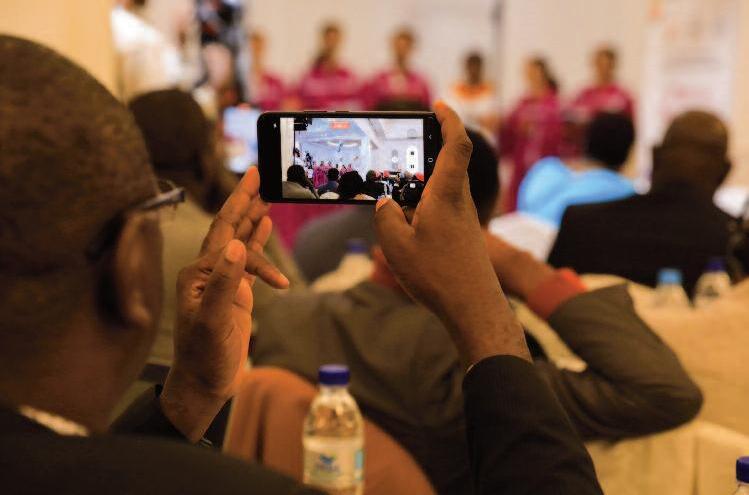
And there is historical precedent for this: in the Middle Ages, much doctrine and moral teaching was in practice interpreted and defined by theologians at the great universities – and then defined by councils, bishops and popes.
The papacy of Pope Francis suggests that there might be changes to how we apply the teachings and disciplines of the Church. Would such changes be enforced throughout the global Church?
I don’t know Some may be, others may be left to regional and local discretion And that is a good thing We don’t need to have, nor indeed even now do we have a Church that is uniform
M y w o r r y i s t h a t t h e s y n o d a l process will not be followed in its implem e n t a t i o n L o c a l C h u rc h l e a d e r s h i p may simply nod politely, bur y reforms t h e y d o n ’t l i k e , w a i t f o r F r a n c i s ’ d e a t h and a new pope more to their liking A bit like the often lacklustre response in some parts of the Church to the episcopal discretion Francis offered bishops in
speeding up certain classes of annulment cases.
Indications are that Pope Francis foresees a Church where pastoral decisions will be subject to the local cultures, as you have also alluded to. Would that not cause confusion? We n e e d t o g e t b e y o n d t h e l a n g u a g e o f c o n f u s i o n I t ’s a s y n o n y m f o r u n i f o r m i t y, w h i c h i s d i a m e t r i c a l l y o p p o s e d t o t h e p r i n c i p l e o f u n i t y. M a n y c r i t i c s o f t h e C h u rc h a t t a c k u s f o r b e i n g a E u r o c e n t r i c i n s t i t u t i o n a n d f o r m u c h o f t h e C h u rc h ’s h i s t o r y I t h i n k t h e c r i t i c s w e r e r i g h t
If the Gospel is truly for ever yone it must take root and expression in ever y culture. And only as inculturated can it really engage with that culture in a manner that brings faith and culture together
Some people claim that the synod will cause a schism in the Church? Is that an over reaction or is there such a possibility?
Historically, this cannot be ruled out. From the earliest Councils of the Church onwards, decisions have often led to splits. That said, many feel that a “silent schism” has already happened to the “left” and “right” but is being to var ying degrees ignored
At very least we must face that the Church is divided, has been divided throughout its histor y, and the situation will continue no matter who is leading the Church or how it is led
The challenge, which we’ve never successfully addressed, i s h o w t o h a n d l e d i f f e r e n c e s . We c o n f u s e d u n i t y w i t h u n i f o r m i t y, and we forget that there is a hierarc h y o f C h r i s t i a n t r u t h s e v e n a m e a s u r e o f l e g i t i m a t e d i v e r s i t y i n h o w o n e m i g h t i n t e r p r e t s a i d t r u t h s We n e e d t o f i n d a b a l a n c e here, and accusations that such balance is relativism is not helpful, nor true
Could a future pope reverse the outcomes of the synodal process?
I am not sure. It depends on how far and how strongly the idea of synodal leadership “takes” in the Church It is conceivable that a future pope might reverse ever ything but i f t h e i d e a o f s y n o d a l i t y i s t h o r o u g h l y e n g r a i n e d i n t h e Catholic imagination, even if that imagination is culturally diverse and may even disagree on points of detail, such a reversal would be difficult, and even open up the possibility of a schism The more synodalism becomes the default practice of the local, regional and global Church after the Synod ends, the less such a reversal might be possible
F i n a l l y, w h a t c a n w e , a s i n d i v i d u a l C a t h o l i c s a n d a s Church communities, do to implement the outcomes of the synod once the synodal process is completed?

We m u s t e m b r a c e a n d d e f e n d t h e s y n o d a l m e t h o d a n d process in which we have participated, holding leaders to the process not simply as some event we did, but as how we proceed in future
A n d w e m u s t t r y a s f a r a s p o s s i b l e t o i m p l e m e n t t h e Synod in the Church And while we apply it according to our particular cultures, we must be ready to l e a r n a n d u n d e r s t a n d f r o m o t h e r c u ltures who implement it
Fr Anthony Egan is a Cape Townborn Jesuit priest, theologian, historian, lecturer and author. He currently teaches theology at Hekima University College in Nairobi, Kenya. We most recently interviewed him on ten years of Pope Francis in our March 2023 issue
‘We don’t need to have, nor indeed even now do we have, a Church that is uniform’


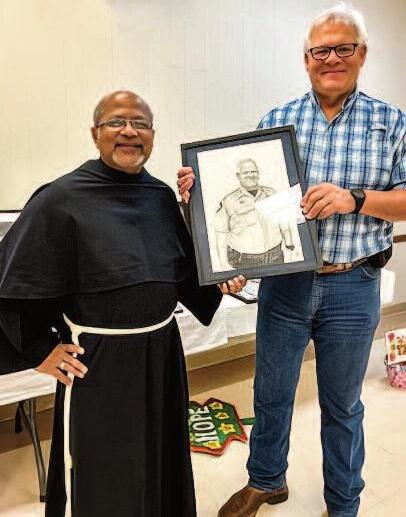
B y M i c h e l l e C a s w e l l
APRIEST WHO SERVED 19 YEARS a s a m i s s i o n a r y i n S o u t h A f r i c a h a s r e s p o n d e d t o a d v e r s i t y s i n c e h e w a s p o s t e d t o t h e U n i t e d S t a t e s w i t h a n i n n o v a t i v e s o l ut i o n To d a y t h e p a r i s h i o n e r s o f O u r L a d y o f P e r p e t u a l H e l p c h u rc h i n J e nn i n g s , L o u i s i a n a , f e e l b l e s s e d a t h a v i n g F r J u d e F e r n a n d o T O R a s t h e i r p a r i s h p r i e s t F r F e r n a n d o s e r v e d i n S o u t h A f r i c a f o r 1 9 y e a r s , f r o m 1 9 9 8 t o 2 0 1 7 I n t h a t t i m e , t h e S r i L a n k a n p r i e s t o f t h e T h i r d O r d e r R e g u l a r o f S t F r a n c i s s e r v e d a t S t P a t r i c k ’s m i s s i o n i n M a r ia n n h i l l d i o c e s e , f r o m 2 0 1 0 - 1 4 a t S t A n n e ’s m i s s i o n i n M p o p h o m e n i i n t h e a rc h d i o c e s e o f D u r b a n , a n d u n t i l 2 0 1 7 a t O u r L a d y o f G o o d H e l p c h u rc h i n Ve r u l a m I n h i s t i m e i n S o u t h A f r i c a , h e w a s k n o w n f o r h i s w o r k w i t h y o u n g C a t h o l i c s a n d e v e n w r o t e a c h i l d r e n ’s b o o k H e w a s s e n t t o t h e U S i n 2 0 1 7 F r F e r n a n d o h a d s e r v e d t h e p a r i s h o f J e n n i n g s f o r f o u r y e a r s w h e n i t w a s t i m e f o r h i s w o r k v i s a t o b e r e n e w e d M a n y d i f f i c u l t i e s a n d u n f o r e s e e n p r o bl e m s a r o s e H i s v i s a w a s n o t a p p r o v e d i n t i m e f o r h i m t o s t a y i n t h e U n i t e d S t a t e s , s o h e w a s s c h e d u l e d t o f l y h o m e o n D e c e m b e r 3 , 2 0 2 1 T h e d a y b e f o r e h e w a s t o l e a v e , F r F e r n a n d o r e c e i v e d a p h o n e c a l l w i t h t h e n e w s t h a t h e c o u l d s t a y i n t h e U S u n t i l h i s v i s a w a s a p p r o v e d W h a t a n A d v e n t m i r a c l e t h a t w a s ! B u t t h e n e w s c a m e w i t h s t r i n g s a tt a c h e d F r F e r n a n d o w a s a l l o w e d t o l i v e a t t h e r e c t o r y u n t i l h i s w o r k v i s a w a s r e n e w e d , b u t h e w a s n o t a l l o w e d t o r e c e i v e a s a l a r y E v e n t h o u g h h e h a d n o w a y o f k n o w i n g h o w l o n g i t w o u l d t a k e f o r h i s v i s a t o b e a p p r o v e d ( i f a t a l l ) , F r F e r n a n d o w a s t e d n o t i m e b e i n g i d l e I n s t e a d h e u s e d h i s t i m e t o v o l u nt e e r w i t h d i f f e r e n t c o m p a n i e s i n t h e c o m m u n i t y D u r i n g h i s s e v e n m o n t h s
o f v i s a l i m b o , v o l u n t e e r i n g t a u g h t t h e p r i e s t h o w p e o p l e i n h i s p a r i s h w o r k t o p r o v i d e f o r t h e i r f a m i l i e s a n d c h u rc h c o m m u n i t i e s
G e t t i n g o n w i t h t h e j o b s
H e w o r k e d w i t h l o c a l f i s h e r m e n i n t h e c r a w f i s h i n d u s t r y H e w o r k e d w i t h a l o c a l c o n s t r u c t i o n c o m p a n y, d o i n g o d d j o b s a n d w h a t e v e r t h e y n e e d e d h i m t o d o H e w o r k e d f o r a n e l e c t r i c i a n d o i n g j o b s a s t h e y c a m e u p a n d h e l p e d w h e r e v e r h e w a s n e e d e d H e p a i n t e d h o u s e s a n d b u s i n e s s b u i l d i n g s w i t h a p a i n t i n g c o m p a n y H e w o r k e d w i t h a t r e e - f e l l i n g c o m p a n y, c u t t i n g a n d c l e a n i n g u p a f t e r t h e j o b s w e r e d o n e H e w o r k e d a t a l o c a l c a t e r i n g b u s i n e s s , p r e p a r i n g f o o d a n d l e a r n i n g h o w t o m a k e c a k e s a s w e l l H e w o r k e d w i t h a t o w i n g s e r v i c e a n d a s s i s t e d w i t h w h a t e v e r w a s n e e d e d . H e a l s o w o r k e d f o r a h y d r a u l i c s c o m p a n y I n s h o r t , F r F e r n a n d o w a s v e r y b u s y i n t h e m o n t h s w h e n h e w a s u na b l e t o m i n i s t e r i n h i s p a r i s h I n t h e

p r o c e s s h e g a i n e d v a l u a b l e k n o w l e d g e a b o u t a l l o f t h o s e a r e a s o f w o r k , a n d a n i n s i g h t i n t o t h e l i v e s o f t h e p e o p l e h e w a s c a l l e d t o s e r v e T h e p r i e s t t u r n e d o u t t o b e a g r e a t w o r k e r a n d e n j o y e d a l l o f t h e e x p e r i e n c e s i n w h i c h h e w a s a b l e t o p a r t i c i p a t e F r F e r n a n d o a l s o s t a r t e d a p r i s o n m i n i s t r y i n J e n n i n g s N o p a r i s h p r i e s t i n o u r a r e a h a d e v e r t a k e n t h e t i m e a n d i n i t i a t i v e t o m i n i s t e r t o t h e i nm a t e s a t o u r l o c a l j a i l F r F e r n a n d o i s w o r k i n g c l o s e l y w i t h S h e r i f f I v y Wo o d s t o o f f e r i n m a t e s h o p e i n t h e i r l i v e s To p r e p a r e f o r t h i s m i n i s t r y, t h e p r i e s t r o d e a l o n g w i t h t h e p o l i c e d u r i n g w o r k h o u r s t o u n d e r s t a n d a l l o f t h e r e s p o ns i b i l i t i e s o f t h e l o c a l s h e r i f f ’s d e p a r tm e n t F r J u d e o f f e r s a b e a u t i f u l e x a m p l e o f c h a r i t y a n d l o v e t o t h e p r i s o n e r s w h i l e s h a r i n g t h e Wo r d o f G o d w i t h t h e m . F r F e r n a n d o h a s m i n i s t e r e d t o m a n y C a t h o l i c s w h o h a v e r e t u r n e d t o t h e C h u rc h a n d n o w a t t e n d M a s s w e e k l y. H e h a s c o u n s e l l e d t h e m a n d p r e p a r e d t h e m t o r e c e i v e t h e s a c r am e n t s . H e w o r k s t i r e l e s s l y t o b r i n g t h o s e w h o h a v e f a l l e n a w a y f r o m t h e C h u rc h b a c k i n t o o u r p a r i s h f a m i l y.
B y r e s p o n d i n g t o h i s v i s a t r a v a i l s i n t h e w a y h e d i d , F r F e r n a n d o p r o v i d e d h i s p a r i s h i o n e r s w i t h a b e a u t i f u l e x a mp l e o f n o t t o b e d i s c o u r a g e d i n t i m e s o f d o u b t a n d u n c e r t a i n t y N o m a t t e r w h a t c o m e s o u r w a y i n l i f e , w e s h o u l d a l w a y s f o l l o w G o d ’s e x a m p l e o f c o u r a g e a n d h u m i l i t y.
F r F e r n a n d o h a s u s e d h i s t i m e w o r k i n g i n t h e c o m m u n i t y t o w i t n e s s f i r s t - h a n d w h a t i t t a k e s f o r o r d i n a r y p e o p l e t o t a k e c a r e o f t h e i r f a m i l i e s , t h e i r r e s p o n s i b i l i t i e s a n d t h e i r C h u rc h c o m m u n i t y, a n d h e h a s s e t a n e x a m p l e t o a l l t h a t n o m a t t e r w h a t y o u r c i rc u ms t a n c e s , y o u c a n u s e y o u r t i m e , t a l e n t s , a n d e f f o r t s t o b e p r o d u c t i v e M i c h e l l e C a s w e l l i s a p a r i s h i o n e r o f O u r L a d y o f P e r p e t u a l H e l p c h u r c h i n J e n n i n g s , L o u i s i a n a
A thousand years ago, construction began on what is one of the world’s great Catholic structures: France’s Mont-Saint-Michel, a great abbey on a tiny island. Soléne tadié explains.

EXACTLY A MILLENNIUM AGO, THE FIRST STONE OF the abbey church of Mont-Saint-Michel in French Normandy was laid The monument that the writer Victor Hugo called the “Khéops of the West” a reference to the great pyramid of Giza has since become one of the greatest symbols of French Catholic identity, and one of the most important pilgrimage sites in the world, with more than 3 million visitors a year
This important anniversar y has given rise to a large number of celebrations that will continue until November.
St a n d i n g o n r e l a t i v e l y i n h o s p i t a b l e t e r r a i n , e n t h r o n e d o n a r o c k y i s l e t l e s s t h a n a k i l o m e t r e i n d i a m e t e r, s u r r o u n d e d b y a v a s t s a n d y p l a i n s u b j e c t t o t h e v a g a r i e s o f t h e t i d e s , t h e U n e s c o Wo r l d H e r i t a g e s i t e h a s s t o o d t h e t e s t o f t i m e , o f f e r i n g i t s e l f a s a s p e c t a c l e f o r d o z e n s o f g e n e r a t i o n s t o s e e
Indeed, the histor y of this place of prayer and pilgrimage was as precarious and tumultuous as its surroundings While the construction of the present abbey church dates back to 1023, a first church dedicated to St Michael the Archangel is said to have been built as early as 708 on the mount, then known as Mont-Tombe.
According to the 11th-centur y “Revelation”, the oldest text reporting the context of the abbey’s construction, St Aubert, bishop of Avranches, was visited three times in dreams by the Archangel Michael in 708 The vision instructed the bishop to erect a sanctuar y in his honour on the summit of the site, “so that he whose venerable commemoration was celebrated at Mont Gargan [the first great shrine dedicated to the Archangel Michael in the Puglia region of Italy] might be celebrated with no less fer vour in the middle of the sea”.
St Aubert undertook the building of a first church with the capacity of about a hundred people, consecrated in October 709, and given the name Mont-Saint-Michel-aupéril-de-la-Mer (St Michael's mountain at the peril of the sea)
The prelate installed 12 canons there, responsible for praying the Divine Office and welcoming local pilgrims. The canons were replaced in the 10th centur y by Benedictine monks at the behest of Duke Richard I of Normandy, who had little taste for the canons’ opulent lifestyle
In 1023, the order undertook the construction of the abbey church we know today, based on three rock-cut cr ypts and the former chapel This ambitious project marked a decisive step in the international outreach of the site, where miracles abounded as the flow of pilgrims from all over Christendom expanded
The island was accessible at low tide to the many pilgrims to its abbey, but also defensible as the incoming tide stranded, drove off or drowned would-be invaders as two English attempts on the islet during the Hundred Years’ War (1337-1453) found out
The abbey of Mont-Saint-Michel is bigger than its daughter establishment across the channel, St Michael’s Mount in Cornwall, England, which was also built on an island in a similar conical shape, and also run by the Benedictines
The architecture of Mont-Saint-Michel is impressive “This edifice is like Noah’s ark laid over the cr ypts,” said François Saint-James, a guide and lecturer at Mont-Saint-Michel, in an inter view with Le Devoir newspaper. Emphasising the architectural prowess required for this medieval project, he said: “It was a time when France was covered with ‘a white cloak of churches’, as a monk from Cluny once wrote You have to imagine the gigantic scale of the work. The granite blocks were cut on the Chausey islands, 34km from here.”
While the abbey’s architectural evolution continued uninterrupted until the 19th centur y, one of its highest points was the construction of La Mer veille (The Wonder) in
the 13th centur y, a jewel of Norman Gothic art It consists of two buildings on three levels, supported by high buttresses, with a cloister and refector y, 80 metres above sea level, beneath which an almshouse, a storeroom, and guest rooms were built.
The fame of the shrine started to decline in the 17th centur y, when part of the abbey was turned into a prison by the royal power Seized by central government during the French Revolution of 1789, it became a detention centre for priests deemed hostile to the Jacobin terror.
Listed as a historic monument in 1874, the site was gradually returned to monastic life and its original vocation as a sanctuar y The abbey’s distinctive silhouette was further enhanced by a neo-Gothic spire in 1897, topped by a gilded statue of the archangel

In medieval times, pilgrims walked from Italy, Germany and England, and other parts of France to Mont-Saint-Michel. They were known as Miquelots The same routes can be followed by modern pilgrims Ten hiking trails have been created so that pilgrims from various European countries may retrace the paths of their ancestors in faith
Since 2001, a community of monks and nuns of the Monastic Fraternities of Jerusalem, sent from the mother-house in Paris, have been living on Mont-Saint-Michel They replaced the Benedictine monks who returned to the Mount in 1966 They are tenants of the centre for national monuments and

are not involved in the management of the abbey nor in commercial activity, which is conducted by secular families As of 2019, the island had a population of 29
To mark its 1 000th anniversar y, a special tribute is being paid to the abbey that many have dubbed the “Wonder of the West” with the exhibition “La Demeure de l’Archange” (The Archangel’s Abode), retracing its glorious and tumultuous histor y through some 30 masterpieces, on view until November 5. Many of these items, which include sculptures, scale models, statues, and silver ware, will be on display to visitors to the abbey for the first time
The beauty of this sacred site, trodden by millions of pilgrims over the centuries, has been celebrated and immortalised in the writings of many great Frenchmen of letters over the last few centuries, from Gustave Flaubert to Théophile Gautier and Victor Hugo In particular, it inspired the 1879 novel Les Mer veilles du Mont-Saint-Michel by the prolific writer Paul Féval He had already paid tribute to the monument a few years earlier, in La Fée des grèves, with these lines often quoted by admirers of the famous Mount:
“Twilight broke. Mont-Saint-Michel was the first to emerge from the shadows, offering the golden wings of its archangel to the reflections of the dawning dawn; then the sides of Normandy and Brittany lit up in turn Then again, a sort of light steam seemed to rise from the receding sea, and all was veiled except for the statue of St Michael, which dominated this wide ocean of mist.”
Holy Land: Led by Fr Chris Townsend • 22 September to 1 October




Lourdes & Paris: Led by Fr Christopher Slater • 8-16 May 2024

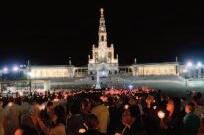

Holy Land & Rome: Led by Mgr Simon Donnelly • 20 May to 1 June 2024



Holy Land: Led by Fr Thabiso Ledwaba • 9 to 18 September 2024
Camino de Santiago de Compostela: 100km route • June 2024
Catholic Portugal: Spiritual Director TBA • October 2024
RELUCTANT PROPHET: Tributes to Alber t Nolan OP, edited by Mike

 Deeb
Deeb
OP, Philippe
DenisOP, Mark
OP ATF Press Publishing Group/UJ Press (2023). 463pp.
 James
James
R485 (print), R340 (ebook)
AD D R E S S I N G T H E L A U N C H o f t h i s b o o k i n C a p e To w n , C a r d i n a l S t e p h e n B r i s l i n c a l l e d t h e l a t e F r A l b e r t N o l a n O P t h e “ G u t i é r r e z o f S o u t h
A f r i c a ” , r e f e r r i n g t o t h e f a m o u s
P e r u v i a n l i b e r a t i o n t h e o l o g i a n a n d
N o l a n ’s D o m i n i c a n c o n f r e r e
F r G u s t a v o G u t i é r r e z .
T h e c o m p a r i s o n w a s
f i t t i n g : a s G u t i é r r e z l e d t h e d e f i n i t i o n o f t h e t h e o l o g i c a l r e s p o n s e t o t h e o p p r e s s i v e r e g i m e s a n d e c o n o m i e s o f L a t i n A m e r i c a , s o d i d A l b e r t N o l a n l e a d t h e C h r i s t i a n t h e o l o g i c a l r e s p o n s e t o a p a r t h e i d a t i t s m o s t h e a t e d t i m e , t h e 1 9 7 0 s a n d ’ 8 0 s N o l a n ’s i n f l u e n c e w a s p r o f o u n d a n d r e a c h e d b e y o n d t h e C a t h o l i c C h u rc h , a n d b e y o n d S o u t h A f r i c a T h e d i v e r s i t y i n t h i s c o l l e c t i o n o f t r i b u t e s a n d e s s a y s o n t h e l i f e , w o r k , t h e o l o g y a n d p e r s o n o f F r N o l a n t e s t i f i e s t o t h a t . T h e b o o k ’s 7 0 - p l u s c o n t r i b u t o r s c o v e r m a n y d i f f e r e n t c h u rc h e s a n d t e r r i t o r i e s . T h e e d i t o r s F r M i k e D e e b , B r P h i l i p p e D e n i s a n d F r M a r k J a m e s , a l l D o m i n i c a n s h a v e c o m p i l e d a s m a r t c r o s s - s e c t i o n o f p e r s p e c t i v e s w i t h o f f e r i n g s b y t h e w e l l - k n o w n a n d o b v i o u s , a s w e l l a s b y l e s s e rk n o w n p e o p l e T h e v o l u m e o f c o n t r i b u t i o n s h a s t u r n e d t h i s p r o j e c t i n t o a b i g b o o k , a t 4 6 3 p a g e s H a p p i l y, o n e c a n d i p i n t o i t a t r a n d o m w i t h o u t l o s i n g t h e f l o w Tr i b u t e b o o k s s u c h a s R e l u c t a n t P r o p h e t a t i t l e t h a t n e e d s l i t t l e e x p l a n a t i o n a r e h e l p f u l i n p a i n t i n g a p i c t u r e o f i t s s u b j e c t i n a w a y b i o g r a p h i e s c a n n o t T h e e d i t o r s h a v e c a t e g o r i s e d c o n t r i b u t i o n s b y t h e m e s , s k i l f u l l y c r e a t i n g a r o u g h l y c h r o n o l o g i c a l , a n d t h e r e f o r e l o o s e l y b i o g r a p h i c a l , n a r r a t i v e . T h i s b o o k w a s c r e a t e d i n a n a s t o n i s h i n g l y s h o r t p e r i o d o f t i m e , h a v i n g b e e n l a u n c h e d o n l y n i n e
We need no canonisation to know that Nolan is a saint
m o n t h s a f t e r N o l a n ’s d e a t h a t 8 8 o n O c t o b e r 1 7 , 2 0 2 2 B o r n a s D e n n i s N o l a n o n S e p t e m b e r 2 , 1 9 3 4 , i n C a p e To w n i n t o a l o w e r m i d d l e - c l a s s f a m i l y, h e r e c e i v e d t h e r e l i g i o u s n a m e A l b e r t o n j o i n i n g t h e D o m i n ic a n o r d e r i n 1 9 5 4 E v e r y b o d y k n e w t h e p r i e s t s i m p l y a s A l b e r t N o l a n ’s l a s t i n g l e g a c y w i l l b e h i s t h e o l o g i c a l w r i t i n g s , e s p e c i a l l y J e s u s B e f o r e C h r i s t i a n i t y ( 1 9 7 6 ) a n d G o d i n S o u t h A f r i c a ( 1 9 8 8 ) . T h e g e n i u s o f N o l a n ’s t h e o l o g y r e s i d e s i n i t s s i m p l i c i t y, a t h e o l o g y n o t f o r t h e d e n i z e n s o f i v o r y t o w e r s w i t h t h e i r i m p e n e t r a b l e j a r g o n , b u t f o r t h e p e o p l e , i l l u m i n a t e d i n t e r m s t h a t a r e r e l e v a n t t o t h e m . H i s b o o k s w e r e w r i t t e n f o r p a r t i c u l a r c o n t e x t s a n d t i m e s t h e s t r u g g l e a g a i n s t a p a r t h e i d i n S o u t h A f r i c a y e t t h e y t r a n s c e n d t h e i r t i m e , p l a c e a n d c o n t e x t , a n d r e m a i n r e l e v a n t t o d a y.
A p a r t h e i d ’ s f o e
S i n c e N o l a n ’s d e a t h , i t h a s b e e n r e v e a l e d t h a t h e w a s n o t o n l y a n a n t i - a p a r t h e i d a c t i v i s t w h o m t h e S e c u r i t y P o l i c e a c t i v e l y s o u g h t ( f o rc i n g h i m i n t o h i d i n g ) , b u t a l s o a n u n d e r g r o u n d o p e r a t i v e o f t h e e x i l e d A f r i c a n N a t i o n a l C o n g r e s s , i n t h e d o m a i n o f s m u g g l i n g c o m m un i c a t i o n s H o w h u r t N o l a n w a s , l i k e s o m a n y o t h e r s i n t h e s t r u g g l e , b y w h a t t h e A N C h a s s i n c e b e c o m e ! T h e s e s t o r i e s a r e d i s c u s s e d i n t r i b u t e s , a n d o t h e r s i n v o l v i n g s u b j e c t s s u c h a s N o l a n d e c l i n i n g h i s e l e c t i o n a s w o r l d w i d e h e a d o f t h e D o m i n i c a n s , h i s l e a d e r s h i p o f i t s l o c a l p r o v i n c e , h i s p i o n e e r i n g t h e o l o g i c a l w o r k , h i s f o u n d i n g a n d e d i t o r s h i p o f t h e e c u m e n i c a l C h a l l e n g e m a g a z i n e , h i s m e n t o r s h i p
F r A l b e r t N o l a n O P
i n 1 9 8 3 .
i n t h e Yo u n g C h r i s t i a n S t u d e n t s m o v e m e n t , h i s p i v o t a l r o l e i n t h e d r a f t i n g o f t h e K a i r o s D o c u m e n t , a n d a l s o h i s p h y s i c a l d e c l i n e w i t h t h e o n s e t o f o l d a g e A s i t s h o u l d b e i n a b o o k o f t r i b u t e s t o a m a n w h o l o v e d t o l a u g h , t h e r e a r e m o m e n t s o f l e v i t y. O n e a m u s i n g t a l e i n v o l v e s N o l a n c r o s s i n g o v e r t h e b o r d e r i n t o L e s o t h o w h i l e o n t h e r u n f r o m t h e S e c u r i t y P o l i c e T h e y w e r e l o o k i n g f o r A l b e r t N o l a n , b u t h i s p a s s p o r t i d e n t i f i e d t h e t r a v e l l e r b y h i s c i v i l n a m e , D e n n i s . B y i t s n a t u r e , a n y b o o k o f t r i b u t e s t e n d s t o l e a n t o w a r d s t h e h a g i o g r a p h i c a l , a s F r D e e b c a u t i o n s i n h i s a s t u t e i n t r o d u c t i o n I n d e e d , a s D r B r i a n R o b e r t s o n p o i n t s o u t , w e n e e d n o c a n o n i s a t i o n t o k n o w t h a t N o l a n i s a s a i n t w i t h G o d H o w e v e r, s o m e c o n t r i b u t o r s r a i s e c r i t i q u e o f e l e m e n t s o f N o l a n ’s t e a c h i n g s , m o s t e l o q u e n t l y F r N e i l M i t c h e l l O P I t i s r i g h t t h a t w e s h o u l d i n t e r r o g a t e N o l a n ’s t h e o l o g ic a l p o s i t i o n s , a s h e h i m s e l f w o u l d k e e n l y a g r e e . T h e b o o k i s i l l u s t r a t e d w i t h m a n y p h o t o s o f N o l a n a t v a r i o u s s t a g e s i n h i s l o n g , f a s c i n a t i n g l i f e . A f o r m a l b i o g r a p h y o f N o l a n i s s t i l l n e c e s s a r y, m u c h a s h e m i g h t h a v e a r g u e d t h a t i t i s n ’ t W h e n t h e t i m e c o m e s t o w r i t e i t , R e l u c t a n t P r o p h e t w i l l s e r v e i t s a u t h o r a s a p r e c i o u s r e s o u r c e I n t h e m e a n t i m e , i f w e w a n t t o k n o w A l b e r t D e n n i s N o l a n O P, w e h a v e h a p p y r e c o u r s e t o t h e t e s t i m o n i e s o f h i s f r i e n d s i n t h i s b o o k , a n d h i s b o o k s R e l u c t a n t P r o p h e t i s a v a i l a b l e i n C a t h o l i c b o o k s h o p s , o r o r d e r v i a u j o n l i n e p r e s s u j a c z a / i n d e x p h p / u j p /
c a t a l o g / b o o k / 2 0 8
I n 2 0 0 6 , a te e n a ge r d i e d i n I ta l y. To d ay, t h re e ye a rs af te r h i s b e at i f i cat i o n , d evo t i o n to C a r l o A c u t i s h a s s p re a d a l l ove r t h e wo r l d . T h i s i s t h e l i fe o f t h e f i rst
M i l l e n n i a l s a i nt , w h o to d ay wo u l d st i l l b e o n l y 3 2 .
WHEN YOUR COMPUTER is playing up, a holy teenager may be invoked to intercede for you on matters technological Carlo Acutis was known at school as a “computer geek”, having built a website on Eucharistic miracles by the time he was 11. This remarkable young Italian teenager lived a life dedicated to God and technology, cruelly cut short by leukaemia when he was only 15 years old
Carlo was born on May 3, 1991, in London to Italian parents, Andrea Acutis and Antonia Salzano. Although his parents were not particularly religious, they ensured that Carlo was baptised in the church of Our Lady of Dolours in Chelsea The family was well-off, and moved to Milan when Carlo was still an infant

Carlo was four years old when his recently deceased grandfather appeared to him in a dream, asking to be prayed for.

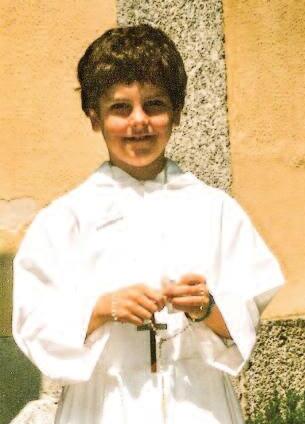
r 1 0 , 2 0 2 0

F e a s t : O c t o b e r 1 2
P a t r o n a g e s : Y o u t h , c o m p u t e
p r o g r a m m e r s
His Polish babysitter further instructed the boy in the Catholic faith When he was seven, he requested to receive First Communion, even though the family was not attached to a parish After that, Carlo attended Mass every week or even daily, made weekly confession, prayed the rosary, and developed a special devotion to the Blessed Sacrament At the age of age 11, Carlo became a catechist.
Usually it is the parents dragging their children to church. In Carlo’s case, the converse was true: he dragged his parents to church. Antonia Acutis attributes her conversion to her son’s guidance
From an early age, Carlo showed an exceptional talent for working with computers. By the time he was nine years old, Carlo had already taught himself programming and web development. Driven by a desire to share his faith, at the age of 11, he launched a project that
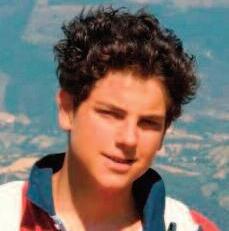


was ambitious for a person of any age: to catalogue Eucharistic miracles, researching and documenting them meticulously, to create an online virtual museum. By the time it was completed in 2005, “The Eucharistic Miracles of the World” website was a comprehensive collection of more than 130 Eucharistic miracles from all over the world. Since Carlo’s death, it has lived on in the form of a physical display, with his work (and updates) being exhibited all over the world, including Southern Africa.
Carlo believed that technology could be a powerful tool for evangelisation in a way that even most Church leaders couldn’t (or even now, cannot) conceive, reaching people where they are, even in their homes.
Carlo was educated at the Jesuit Instituto Leone XIII high school in Milan. There he defended weaker schoolmates, especially those with disabilities, from
A b o v e : A n t o n i a S a l z a n o w i t h h e r b a b y s o n
C a r l o A c u t i s i n
1 9 9 1
L e f t : C a r l o a s a n a l t a r s e r v e r i n M i l a n
A b o v e : T h e a n i m a l l o v e r C a r l o a s a b o y w i t h o n e o f h i s d o g s .

L e f t : C a r l o a t d i f f e r e n t a g e s a t
C h r i s t m a s

‘I f w e get in f ront of the sun, w e get suntans – but when w e get in f ront of Jesus in the Euchar ist, w e become saints. ’




1 9 9 1
B o r n o n M ay 3 t o I ta l i a n p a re n t s , A n d re a A c u t i s a n d A n t o n i a S a l za n , i n L o n d o n . Fa m i l y m o v e s t o M i l a n i n S e p t e m b e r
1 9 9 8
Re c e i v e s h i s F i rs t C o m m u n i o n .
2 0 0 2





Re c e i v e s t h e s a c ra m e n t o f c o n f i r m a t i o n .
2 0 0 3
S ta r t s d o c u m e n t i n g E u c h a r i s t i c m i ra c l e s w o r l d w i d e a n d s e t s u p a w e b s i t e t o c a ta l o g u e t h e m
2 0 0 5
C o m p l e t e s w o r k o n t h e E u c h a r i s t i c m i ra c l e s w e b s i t e
2 0 0 6
I s d i a g n o s e d w i t h a c u t e l e u ka e m i a i n e a r l y O c t o b e r, a n d d i e s o n O c t o b e r 1 2 , a t h e a g e o f 1 5 H e i s b u r i e d i n A s s i s i , a c c o rd i n g t o h i s o w n w i s h
2 0 1 0
O n t h e fo u r t h a n n i v e rs a r y o f
C a r l o ’s d e a t h , h i s m o t h e r g i v e s
b i r t h t o t w i n s a t t h e a g e o f 4 4 .
S h e a tt r i b u t e s i t t o h e r s o n ’s
i n t e rc e s s i o n .
2 0 1 3
T h e L o m b a rd y E p i s c o p a l
C o n fe re n c e a p p ro v e s a p e t i t i o n fo r C a r l o ’s c a n o n i s a t i o n c a u s e t o p ro c e e d , a n d h e i s d e c l a re d a S e r va n t o f G o d .
2 0 1 8
Po p e F ra n c i s c o n f i r m s C a r l o ’s l i fe a s o n e o f h e ro i c v i r t u e o n J u l y 5 , a n d d e c l a re s h i m Ve n e ra b l e .
2 0 1 9
A m i ra c l e i n B ra z i l i nv o l v i n g a fo u r- ye a r- o l d b o y i s a tt r i b u t e d t o C a r l o ’s i n t e rc e s s i o n
2 0 2 0
Po p e F ra n c i s b e a t i f i e s C a r l o o n
O c t o b e r 1 0 i n A s s i s i , i n t h e p re s e n c e o f t h e A c u t i s fa m i l y
2 0 2 3
A t rav e l l i n g ex h i b i t i o n o n
E u c h a r i s t i c m i ra c l e s b a s e d o n
C a r l o ’s w e b s i t e i s l a u n c h e d i n
S o u t h e r n A f r i c a , h av i n g b e e n
d i s p l aye d i n m a ny o t h e r c o u n t r i e s
bullies. When a friend’s parents were divorcing, Carlo supported him by including him in the Acutis’ family-life
Besides being a “computer geek”, Carlo also had normal hobbies, like football, watching action movies and playing video games (but only for limited periods of time) Like his hero, St Francis of Assisi, Carlo loved animals, and had four dogs, two cats and many goldfish He enjoyed travelling, especially on pilgrimage, and the town of Assisi was his favourite His tomb is in this city of St Francis, in accordance with Carlo’s explicit wish.
The boy was also mature beyond his age in his love for those on the margins He engaged in charitable acts, assisted the elderly, volunteered at homeless shelters, supported migrants (even sponsoring one at his baptism), and comforted the sick

In October 2006, Carlo himself became sick, as he had predicted At the age of 15 he was diagnosed with leukaemia, with only days to live He bore his suffering with resolute faith, offering his pain as a sacrifice for the Church, praying for the conversion of sinners and for an end to the culture of indifference. Even during his illness and knowing that he would die very soon, Carlo continued to spread his message through his website and by sharing his personal experiences.


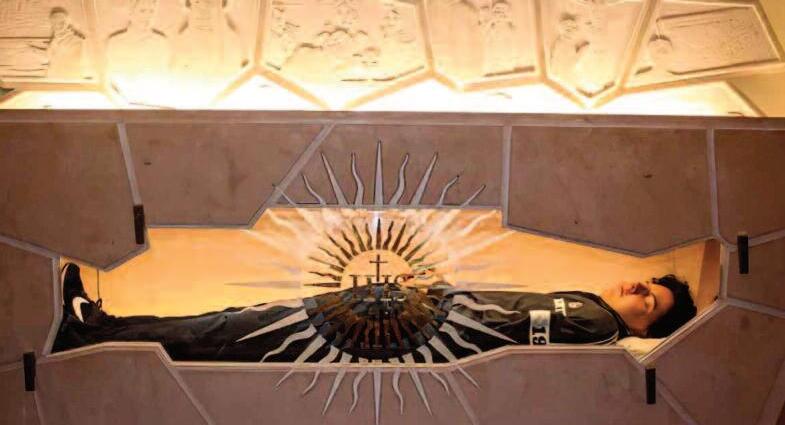

On October 12, 2006, at 18:45, Carlo Acutis died in the city of Monza. Shortly before, he had said: “I am happy to die because I have lived my life without wasting a minute on those things which do not please God ” His funeral drew thousands of people, and his story began to spread worldwide. Four years to the day after his death, Carlo’s mother gave birth to twins, at the age of 44. She attributes this to her son’s intercession
His sainthood cause was opened in 2013, culminating in his beatification on October 10, 2020, by Pope Francis in the upper basilica of St Francis in Assisi. His parents and siblings attended the ceremony Carlo’s remains, dressed in his favourite clothes, are kept in a glass coffin in the church of Santa Maria Maggiore in Assisi
Carlo once said: “All people are born as originals, but many die as photocopies ” He stands as an original in a world that is often marked by superficiality and materialism
Carlo’s example urges us to use technology as a means of evangelisation and to promote genuine human connection and solidarity
Next Month: St Charles Borromeo
AMONG THE SISTERS IN A congregation in Brazil, there are the Dos Santos triplets: María Gorete, María de Lourdes, and María Aparecida. The 57-year-old nuns belong to the Franciscan Congregation of the Sacred Heart of Jesus

Born into a Catholic family of 17 siblings in a rural region of Brazil’s north-eastern Bahía state, they felt their vocation awakening in childhood “We didn’t know what it was like, we just wanted to be religious It was something that only God can explain,” Sr María Gorete said.
Srs Gorete, Lourdes, and Aparecida are from the small town of Itamira in the district of Aporá There they met a nun from Italy, Sr Ricarda, when they were children. The nun’s witness made them want to follow the same path
“She visited the communities where we attended holy Mass and, while the parish priest ministered to the people, she gathered the children, seated them in front of the altar, put on a record player, and taught us,” Sr Gorete said. She recalled that Lourdes then said: “When I grow up, I want to be like this Sister ”
“That made us feel the call even more. We grew up with this idea, which matured, and we lived with this ideal,” Sr Gorete told ACI Digital, a Portugueselanguage Catholic news agency
Sr Gorete recalled that her mother, Josefa Mendes de Souza, stated that she would not let her daughters leave the parental house unless it was to marr y or to enter religious life However, the family didn’t know how to make the triplets’ dream of entering religious life happen.
A priest who celebrated Mass in the region learned about their desire and contacted the superior of a convent in Salvador, the capital of Bahía, who said she could take the young women. The first to follow the call to a vocation was Sr Lourdes in 1984.
Sr Gorete recalled that Aparecida also wanted to go, but her mother said that “it wasn’t possible at that time as we had to help with the younger siblings And the mother [of the house] also helped the elderly people in the
community, because in the countr yside they needed help to gather firewood, since there was no gas or electricity, to wash clothes in the river, because there was no tank ... So, we had to help her.”
A year after Sr Lourdes went to the convent, Sr Aparecida followed the same path and, after another year, it was Sr Gorete’s turn
For Sr Gorete, there might have been “a bit of influence from one sister to the other, because the first one pulled us along”, but she clarified that “each woman has her ideal of being a religious, of consecrating her life to God This was maturing, and our desire was growing more and more.”
For a year the three lived in the same convent, in Salvador. “It was good for us to be together, because we strengthened each other,” Sr Gorete said
However, the presence of the triplets “created a lot of confusion in the convent”, because although each of them worked in a different place, when a fellow Sister spoke with one of the triplets and then with another, she thought she had spoken to the same person
Currently, Sr Gorete is in São José dos Campos in São Paulo state Sr Lourdes is in the convent of Santa Clara do Desterro in Salvador Sr Aparecida is spending time at home, taking care of their 85-year-old mother. “Today, our mother needs care and wants us close
So we talked to our mother superior and we may stay with our mother We’re going to take turns caring for her,” Sr Gorete explained
For her, following religious life is rewarding “It’s worth leaving everything, leaving the family It’s not like abandoning the family but following what Jesus says: If you want to follow me, renounce everything you have, pick up your cross, and follow me It gives life meaning,” she said
“By deciding to follow Jesus, we prepare ourselves for whatever comes We don’t know what’s ahead, but we know we’re not alone So, we have the courage to give up ever ything and go without fear. The apostles followed without fear and fulfilled their mission
We are here in the world to carr y out our mission of ser ving, whether in the family, in the convent wherever God wants us,” Sr Gorete concluded
This story was first published by ACI Digital It was been translated and adapted by the Catholic News Agency.

Amid South Africa’s many social problems, a Catholic NGO is helping communities in the Northern Cape empower themselves, as Rosanne Shields explains.
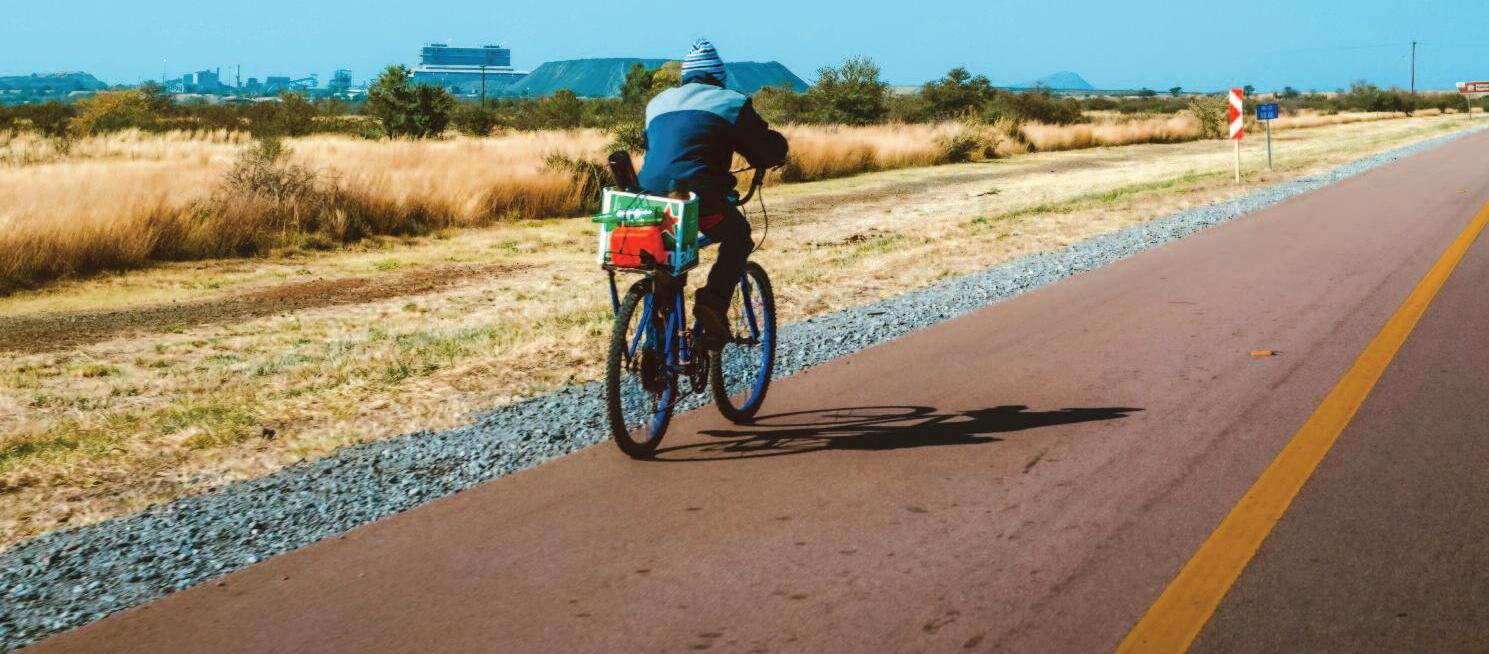
Oof problems serious problems which impact on people’s daily lives in a very real way While these issues are sometimes over whelming, we need to keep hope alive and look to those who have the courage to get up every morning, not to tell God how big these problems are but to tell these problems how big God is
The Rural Development Support Program (RDSP) is a small, tightly-knit Church organisation that slots in under the Social Action Department of the Southern African Catholic Bishops’ Conference. In 2022 it celebrated 30 years of pioneering rural social development work
RDSP has always punched above its weight and in 30 years the team, which I have had the honour of serving with for several years, has worked directly with over 30 000 people living in rural parts of southern Africa people who themselves are determined to change their rural realities of poverty, unemployment and neglect
One aspect of RDSP’s work over the last three decades is in the field of gender-based violence (GBV) This is a rather sanitised phrase for the harsh reality of aggression, violence, abuse, and in many cases death, experienced by many women, children and some men at the hands of those who have forgotten their humanity. RDSP has become a reluctant expert in this field, in a most practical way, by working side by side with rural people who are experiencing this scourge and are trying to halt it While RDSP does have a broader footprint, its work on GBV has been focused on the Northern Cape This has grown to include the related field of substance abuse
Fortunately, for every aggressor there is somebody else who cares deeply; for every person stripped of their dignity through the huge prevalence of alcohol and drug abuse there is somebody waiting to help in rehabilitation RDSP’s stor y is one where these rural givers the angels among us are identified and supported in finding solutions to the myriad social challenges from which government has largely walked away.
How does this work in practice? Drive past most dusty rural towns in the three Cape provinces and a few things may strike you Firstly, the “better” end of town Apart from the obligatory kerk, it often includes a bit of old colonial architecture, some 1950s bungalows, the local fuel station, most likely a Pep store and a (probably defunct) post office, a couple of bottle stores, and maybe a second-hand shop.
Secondly, there is the “location”, where those members of the community classified as coloureds were assigned a living
Karoo lamb at the local hotel ever y evening but not good enough to live in “town”
Thirdly, there’s a sprawling “township” of poorly-built RDP matchbox houses and tin shacks, shimmering in summer and shivering in winter. In the absence of real employment, its people are almost entirely dependent on social welfare grants.
Many of us race past these towns, averting our eyes from the poverty. But if you’re a RDSP staff member, you stop, check in for the week and start listening, from one end of town to the other Pretty soon people will emerge, fully informed of local challenges and what few resources there are, some with fully-fledged projects they have started and others with just a dream and desire for change
We live in a country where at least 150 cases of rape are reported to the police daily We know that the crime of rape is dramatically under-reported and that the number of people being raped is most likely closer to ten times the official stats That’s 1500 people per day, or one person every minute Some experts in the field say the rate could be as high as one person every 30 seconds
Globally, South Africa ranks among the countries with the highest rates of violence against women, girls and children. Statistics SA says one in five women has experienced physical violence by a partner. According to the SA Police Service, 558 children were killed in just six months last year, with another 294 attempted child murders
Substance abuse among children and teenagers is rampant, with addicts as young as eight not uncommon The neglect and abuse of children has reached epic proportions We are failing to protect our most vulnerable
Rural areas are not immune to this pandemic of violence
Indeed, they face it through the veil of police indifference, isolation and the fact that it is far more difficult to break free from abuse in a small town than it is to seek help in a city. In rural areas there is minimal access to formal psychosocial support a
substance abuse problems There are ver y few “safe spaces” where women and children can take shelter when abuse starts in the home, and with employment options so limited, for most women financial independence is a pipedream

RDSP director Brenda Snyders started working in this field when she joined RDSP almost 20 years ago. What she observed
right away was a great willingness and desire on the part of small community organisations and church groups to tackle what was unfolding around them, but not always knowing where to even begin
Brenda herself wished to know more, to understand the psychological and social causes of abuse, so as to find solutions within communities She made the decision to accompany these women, and some men, at community level in a process of research, learning and experimenting. Her work has taken her from the tiny hamlet of Spoegrivier right through the Namaqualand and up to the villages around Kuruman
Three major strategies have been implemented and they are having an impact Firstly, men and women who are affected by GBV and/or substance abuse have formed community support groups. These groups choose their own focus, which could be how to deal with an abuser in the home or coping with children battling substance abuse When and where they meet is up to them. The groups are flexible and the intention is that there is no judgment, just empathy and constructive help
After attending many of these groups’ meetings, Brenda says: “I was really struck by the resilience of the women and how they support one another in spite of their own circumstances. It is always a very moving experience.”
Adding another strategy, RDSP then trained the community groups in how to give an information talk on GBV and substance abuse, for example at high schools and churches. They also introduced the use of hand puppets to educate younger children, with characters telling a story and teaching the morality of care for one another.
Thirdly, for those choosing to go a level further, RDSP also provides training in trauma debriefing This intends to address the huge gap in social development services that should be provided by government and the current shortage of social workers, a red flag that is being waved not nearly enough
Two women in the heart of Namaqualand really stand out as RDSP local partners, having worked with Brenda from the start One is Colleen Cloete, who runs Sprankie Hoop in Nababeep Colleen is a dynamic community leader who uses her deep faith to inspire others. She says: “After RDSP’s training we founded a support group for women who have family members abusing substances This led to more informed women who helped to change behaviour, with some family members going to rehab RDSP took us to different rehab centres to learn how they work, which was a big eye opener.”
Elize Brandt runs the Bergsig Ondersteunings Groep, just outside Springbok, where she has a range of community support groups. In her quiet, determined way, she has changed many lives for the better Elize embraced an opportunity RDSP

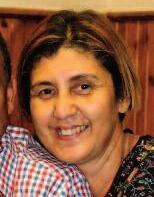
provided to run a small bakery: “The Mama Mimi oven that we have received has really helped us when the funding was scarce, and we still use it to generate an income and keep our doors open ”
While RDSP has funding to provide training and mentoring services, including since inception from the great Catholic funding agency Misereor in Germany, the community-based groups and projects it serves are not as fortunate A decision was made to launch the Mar y Lack Community Grants Programme, which raises funds specifically for the GBV and substance abuse projects of the Northern Cape
Grants are small, at R5 000 each, but enable those who are now skilled in the field to work particularly with teenagers and children to inform, change attitudes and question the stereotypes that have made GBV acceptable in our society
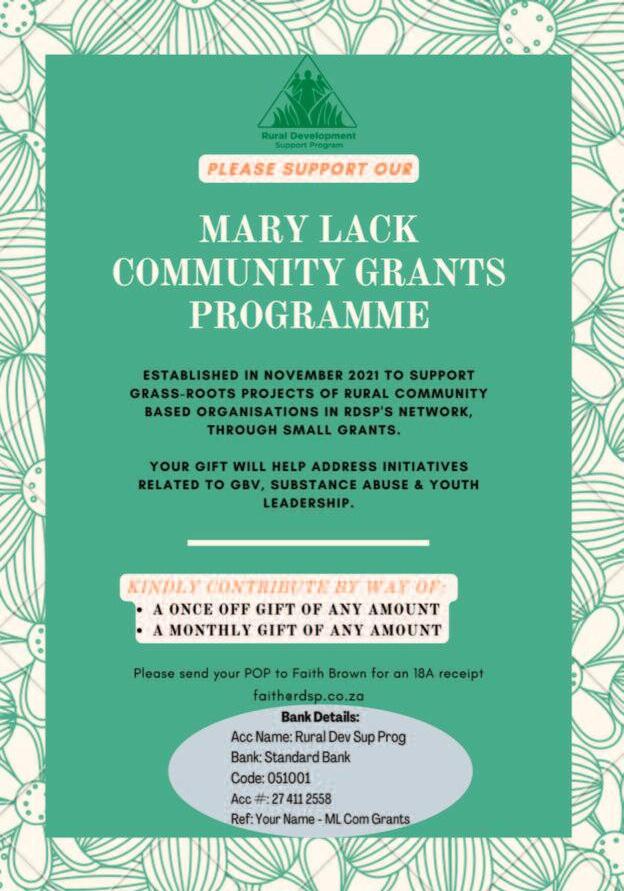
The fund is named after the well-known and much-loved Church activist and community worker Mary Lack, who came to South Africa from England in 1965 Mary could not tolerate injustice or poverty and believed that service to God was best achieved through serving the poor and the vulnerable.


She believed in long-term solutions to poverty and had a great affinity in particular for women caught up in painful situations. Venture up to Namaqualand in the Northern Cape and you will meet many people who knew and deeply respected Mary As a volunteer and longtime board member of RDSP she carried out dozens of field trips there and to the Eastern Cape Mar y passed away in May 2021 and the fund is named in her honour
We all ask ourselves how we might even start to address these mammoth problems faced by rural communities, where life itself seems to have no value and people’s dignity is so systematically degraded. Do we as ordinary people have a responsibility to engage with such distress? RDSP, Brenda, Colleen, Elize, Mary and many others always said yes
To support RDSP’s work, visit www rdsp org za or email brenda rdsp@mweb co



Over the past fe w decades, Halloween has become popular across the world. There is, howe ver, a Catholic alter native to the tricking-and-treating in monster outfits: Holywins!
THE ANNUAL CELEBRATION OF “Holywins”, which is short for “Holiness wins”, is a Catholic initiative that originated in Paris in 2002 with the aim of celebrating the eve of All Saints on October 31, widely marked as Halloween, in a Christian way Over time, this celebration has spread to the rest of the world.
On that day, many parishes and Catholic communities gather to celebrate Mass, participate in eucharistic adoration and prayer meetings, and take part in recreational activities to encourage the participation of children, young people, and their families.
At the celebrations, it is customar y for children to dress up as their favourite saints, to discuss the exemplar y lives of the saints, and to remind each other of the call to sainthood In addition, games are usually played, lively songs are sung, and food and sweets are shared
The diocese of Alcalá de Henares in Spain has been putting on a complete Holywins programme for children and youths since 2009 It includes games, workshops, a procession to the cathedral, activities for the evening, and eucharistic adoration
The diocese has explained that “the phonetic similarity with the word ‘Halloween’ is not accidental, since Holywins seeks to help reinforce the Christian festival of All Saints in the face of [an] increasing” pagan influence on Halloween

The diocese pointed out that although “Halloween means ‘All Hallows Eve’ in English, currently this celebration has no relation to the Christian faith On the contrar y, its way of approaching life and death, good and evil, is completely
different from that of the Gospel of Christ and the tradition of his Church.”
Holywins is an initiative that seeks to encourage breaking with “the cult of death and the exaltation of the monstrous or ugly that it brings with it, since what is proper to Christians is to celebrate the triumph of life and
promote beauty and goodness”, the diocese said.
Holywins seeks to “convey the same message: life is beautiful and its goal is heaven, there are many who have already arrived and we are all called to share their happiness, since we can all be saints”.

The diocese also noted that “with the costumes of the living dead that fill the streets of the cities on October 31 [for the celebration of Halloween], more and more dioceses are joining the celebration of Holywins. We Catholics want to return to this day its true meaning and celebrate all those who heroically followed Jesus Christ, with a luminous feast of All Saints that over flows with joy and hope,” it concluded
Here are some ideas to celebrate Holywins with your family.
No large investment is needed to make a costume, and with the help of some fabrics or household items, a good
For example, to dress up as St Catherine of Siena, all that is needed is a long white or cream-coloured dress that represents the habit of the Dominican order and a black cloth in the form of a veil used by nuns to cover their heads In addition, a crown of dr y branches can be made for the head and a cross and a small bouquet of lilies can be carried in the hand.
To dress up as St Rose of Lima, you can use the same habit used for St Catherine of Siena, only changing the crown of dr y branches for one of red roses To represent St Dominic Savio, the patron saint of children’s choirs, you need only brown trousers, a green jacket, a white shirt, and a bow-tie To dress as St Ignatius of Loyola, a black robe is all that is needed; for St Francis of Assisi, a brown robe.
Ever y celebration is usually accompanied b y f o o d ; t a k e a d v a n t a g e o f t h i s d a y t o c o o k w i t h y o u r f a m i l y a n d p r e p a r e d e s s e r t s a l l u d i n g t o t h e t r a d e o r a c t i v i t y o f w h i c h t h e s a i n t i s t h e p a t r o n , o r w i t h c h a r a c t e r i s t i c e l e m e n t s o f y o u r f a v o u r i t e s a i n t P e r h a p s r e f e r b a c k t o r e c i p e s a n d s t o r i e s b y G r a z i a B a r l e t t a . A s y o u e n j o y t h e m e a l , s h a r e w i t h y o u r f a m i l y t h e s t o r i e s o f
t h e c h o s e n s a i n t o r s a i n t s . F o r e x a m p l e , f o r S t R o s e o f L i m a , y o u c o u l d m a k e c u p c a k e s w i t h f r o s t i n g i n t h e s h a p e o f r e d r o s e s , o r S t F r a n c i s o f A s s i s i , t h e p a t r o n s a i n t o f a n i m a l s a n d e n v i r o n m e n t a l i s t s , y o u c o u l d m a k e
THE NAME MIGHT HAVE been derived from that of a Catholic feast, but the roots of Halloween may be traced back to an ancient Celtic festival called Samhain (pronounced “sow-in”)
Samhain was celebrated by the Celts in Ireland, Scotland, and parts of Britain over 2 000 years ago. It marked the end of the harvest season and the beginning of winter and was also believed to be a time when the boundary between the living and the dead was blurred
When Christianity spread to these regions, the faithful sought to accommodate pagan festivals with Christian ones When in the 8th century, Pope Gregory III designated November 1 as All Saints’ Day a day to honour all the saints and martyrs who did not have a specific feast day of their own the evening before, October 31, became popularly known as All Hallows’ Eve (or Hallowe’en), with “hallow” meaning “saint” or “holy”
By associating the existing Celtic festival of Samhain with All Hallows’ Eve, Christians were able to integrate certain elements of the pagan festival into the Christian celebration For example, the belief in spirits and the connection to the dead were incorporated into the Christian understanding of the saints and their intercession for the living.




Over time, Halloween evolved into a more secular holiday with various customs and traditions Some of these customs, like dressing up in costumes and going door-to-door for treats, might have originated from the medieval Christian practice of “souling” or “souling night”, when poor people would go door-to-door on All Hallows’ Eve, offering prayers for the dead in exchange for food or money
Today, Halloween is widely regarded as a festive occasion rather than any kind of religious observance. The global spread of US culture, where the custom of trick-or-treating became a defining experience of childhood, has introduced the secular feast with a Christian name to many parts of the world


o r b u y b i s c u i t s i n t h e s h a p e o f a n i m a l s o r l e a v e s o r t r e e s
3 . C o m e u p w i t h p l a y f u l a c t i v i t i e s a b o u t t h e s a i n t s . I n a d d i t i o n t o t h e p r e p a r e d d e s s e r t s , y o u c o u l d f i l l l a r g e c o n t a i n e r s o r c u p s w i t h s w e e t s , w r a p p i n g e a c h i n a p i e c e o f p a p e r t h a t h a s a n i n s p i r i n g q u o t e f r o m t h e s a i n t o f y o u r d e v o t i o n w r i t t e n o n t h e m . Yo u c o u l d a l s o f i l l c u p s w i t h s w e e t s a n d p l a c e a s h o r t s t i c k o r l o l l i p o p i n s i d e w i t h t h e i m a g e o f a s a i n t g l u e d t o i t L a t e r, y o u c o u l d t e l l t h e s t o r y o f s o m e s a i n t s o r w a t c h m o v i e s o f s a i n t s a s a f a m i l y p e r h a p s a n i m a t e d o n e s f o r c h i l d r e n a n d t h e n a s k q u e s t i o n s t o s e e h o w m u c h f a m i l y m e m b e r s u n d e r s t o o d Wi t h t h o s e w h o a l r e a d y k n o w v a r i o u s s t o r i e s o f t h e s a i n t s , y o u c o u l d e v e n p l a y c h a r a d e s o r p l a y a t r i v i a q u i z . T h o s e w h o a n s w e r c o r r e c t l y c a n b e r e w a r d e d w i t h s w e e t s Yo u c o u l d a l s o h a v e t h e y o u n g e r c h i l d r e n i n y o u r f a m i l y m a k e a d r a m a t i s a t i o n o r p e r f o r m a n c e o f t h e s t o r y, a n e p i s o d e o r a n e c d o t e o f o n e o f t h e i r f a v o u r i t e s a i n t s T h i s a c t i v i t y c o u l d b e m o r e f u n i f t h e y h a v e a c o s t u m e o r s o m e t h i n g a s s o c i a t e d w i t h t h e s a i n t . I n a d d i t i o n , e a c h m e m b e r o f t h e f a m i l y c o u l d b e e n c o u r a g e d t o d r a w t h e i r f a v o u r i t e s a i n t o r m a k e o r i g a m i o r c r a f t s r e p r e s e n t i n g t h e i r p a t r o n
s a i n t o r s o m e c h a r a c t e r i s t i c e l e m e n t o f t h e s a i n t A f t e r w a r d s , e a c h m e m b e r c o u l d e x p l a i n w h y t h e y c h o s e t h a t s a i n t a n d s h a r e a f a v o u r i t e q u o t e o f t h e s a i n t w i t h t h e o t h e r s 4 . D e c o r a t e y o u r h o m e a l t a r a n d p r a y a s a f a m i l y. F i r s t , s e t u p a f a m i l y a l t a r i n y o u r h o m e , i f y o u d o n ’t h a v e o n e a l r e a d y T h i s i s a n e x c e l l e n t p l a c e t o p r a y t h e r o s a r y a s a f a m i l y, a n d t h i s d e v o t i o n a l p r a c t i c e i s b e t t e r d o n e i n c o m m u n i t y t h a n i n d i v i d u a l l y I m a g e s o r s m a l l s t a t u e s o f s a i n t s a r e o f t e n p l a c e d o n a l t a r s f o r v e n e r a t i o n a n d c a n a l s o b e v e r y e d u c a t i o n a l
R e m e m b e r i n g t h a t t h i s s p a c e i n t h e h o m e s h o u l d b e s p e c i a l a n d e n c o u r a g e r e c o l l e c t i o n f o r p r a y e r, t a k e a d v a n t a g e o f t h i s s p e c i a l d a y a n d d e c o r a t e i t a s a f a m i l y w i t h i m a g e s o f y o u r f a v o u r i t e s a i n t s a n d f l o w e r s f o r t h e Vi r g i n M a r y, w h e t h e r n a t u r a l o r a r t i f i c i a l .




T h e n , p r a y t h e r o s a r y w i t h y o u r w h o l e f a m i l y, a s k i n g G o d f o r h o l i n e s s f o r y o u r f a m i l y, a n d d e d i c a t e a p r a y e r t o t h e s a i n t o r s a i n t s o f y o u r d e v o t i o n . E a c h f a m i l y m e m b e r c o u l d r e a d a m y s t e r y o f t h e r o s a r y, a n d a t t h e e n d e v e r y o n e c o u l d s i n g a M a r i a n h y m n T h e c o n c e p t o f H o l y w i n s r e p r es e n t s a f u n C h r i s t i a n a l t e r n a t i v e t o H a l l o w e e n , w h i c h p r e s e n t s d a r k n e s s a s a s o u rc e o f f u n C N A

WE H AV E A L L H E A R D T H E s a y i n g , “ T h e r e a r e t w o s i d e s t o e v e r y c o i n . ” I n f a c t , t h i s s a y i n g i s v e r y m u c h w h a t C h r i s t i a n f a i t h i s a l l a b o u t l o v e a n d j u s t i c e T h e s t o r y o f J e s u s d e p i c t s e x a c t l y t h a t , w i t h t h e w o r d s h e u t t e r e d , “ L o v e o n e a n o t h e r a s I h a v e l o v e d y o u ” s o o n f o l l o w e d b y h i s b e t r a y a l a n d d e a t h .
Wi t h h i s b e t r a y a l , o n e i m m e d i a t e l y t h i n k s o f t h e r o l e o f J u d a s , b u t w e m u s t r e a l i s e t h a t h e w a s o n l y a p a w n i n t h e g a m e T h e r e a l c u l p r i t s w e r e t h e h i g h p r i e s t s , t h e l e a d e r s o f t h e p r e v a i l i n g r e l i g i o n a t t h a t t i m e
T h e p r o m i n e n t r e l i g i o n i n J u d e a c e n t r e d o n t h e Te m p l e w h e r e o n c e a y e a r a d h e r e n t s w o u l d g a t h e r f r o m f a r a n d w i d e t o a t t e n d P a s s o v e r c e l e b r at i o n s T h e r e w e r e , h o w e v e r, o p p o n e n t s t o Te m p l e p r o c e d u r e s , w h o m w e k n o w a s t h e E s s e n e s , w h o w e r e e c h o e d b y J e s u s w h e n h e c a s t i g a t e d e n t r e p r e n e u r s o p e r a t i n g w i t h i n t h e p r e c i n c t o f t h e Te m p l e S i m p l y p u t , J e s u s r a t t l e d t h e c a g e o f t h e r e l i g i o u s e s t a b l i s h m e n t I n a w a y, t h i s i s w h a t P o p e F r a n c i s i s d o i n g w i t h h i s o n g o i n g S y n o d o n S y n o d a l i t y S o m e p r o m i n e n t C a t h o l i c l e a d e r s h a v e o p e n l y c r i t i c i s e d P o p e
F r a n c i s . U S C a r d i n a l R a y m o n d B u r k e r e c e n t l y m a d e t h i s r e m a r k : “ M y o w n p e r s o n a l p r a y e r e v e r y d a y t o o u r L o r d i s t h a t s o m e h o w h e m a k e s i t s o t h a t t h e S y n o d d o e s n ’t t a k e p l a c e , b e c a u s e I c a n ’t f r a n k l y s e e a n y g o o d c o m i n g f r o m i t ” I w o n d e r h o w m a n y o t h e r
C a t h o l i c s a r e h a r b o u r i n g s i m i l a r t h o u g h t s
T h e h u m b l e I t a l i a n c l e r i c w h o b e c a m e t h e p o n t i f f i n 1 9 5 8 , S t J o h n
X X I I I , h a d a v i s i o n w h i c h l e d t o Va t i c a n
I I a n d c o n c r e t e c h a n g e s b e i n g m a d e i n

We welcome your letters, while reserving the right to edit them. We may publish your letters on our website Please include a postal address (not for publication) Letters should be no longer than 350 words. Pseudonyms are acceptable only under special circumstances at the Editor’s discretion Send your letters to editor@scross.co.za Opinions expressed in The Southern Cross, especially in Letters to the Editor, do not necessarily reflect the views of the publication or those of the Catholic hierarchy
t h e C h u rc h H o w e v e r, t h e i m p e t u s w a n e d d u r i n g t h e f o l l o w i n g 5 0 y e a r s P o p e F r a n c i s h a s m a d e i t h i s m i s s i o n t o p i c k u p t h e b a t o n a n d c a r r y o n , r e g a r d l e s s o f h i s c r i t i c s N o t o n l y i s h e c h a l l e n g i n g t h e C h u rc h i n i t s e n t i r e t y, b u t o u r i n d i v i d u a l f a i t h i s a l s o b e i n g p u t t o t h e t e s t J u s t a s J e s u s a s k e d o f h i s d i s c i p l e s , “ F o l l o w m e , ” o u r s h e p h e r d , P o p e F r a n c i s , i s r e q u e s t i n g t h e s a m e o f u s
Patrick Dacey, Johannesburg


CAT H O L I C S D O N O T “ W O R S H I P ” M a r y, a s s o m e p e o p l e m i s u n d e rs t a n d , b u t w e d o h o n o u r h e r. W h e n w e p r a y t h e r o s a r y, w e g i v e h e r h o n o u r, r e m e m b e r i n g t h a t s h e i s t h e M o t h e r o f t h e S e c o n d P e r s o n o f t h e Tr i n i t y B y h o n o u r i n g O u r B l e s s e d
M o t h e r, w e a r e i n g o o d c o m p a n y
l G o d t h e F a t h e r g a v e M a r y t h e g r e a t h o n o u r o f c h o o s i n g h e r t o b e t h e M o t h e r o f h i s S o n “ B e h o l d , y o u w i l l c o n c e i v e i n y o u r w o m b a n d b e a r a s o n , a n d y o u s h a l l n a m e h i m J e s u s T h e H o l y S p i r i t w i l l c o m e u p o n y o u , a n d t h e p o w e r o f t h e M o s t H i g h w i l l o v e rs h a d o w y o u ” ( L u k e 1 : 3 1 - 3 5 ) l W h e n s h e e n t e r e d Z e c h a r i a h ’s h o m e , h e r c o u s i n E l i z a b e t h h o n o u r e d
M a r y w i t h t h e g r e e t i n g : “ A n d h o w d o e s t h i s h a p p e n t o m e t h a t t h e
m o t h e r o f m y L o r d s h o u l d c o m e t o m e ? ” ( L u k e 1 : 4 3 )
l J e s u s h o n o u r e d h i s m o t h e r a s s h e s t o o d a t t h e f o o t o f t h e C r o s s , w h e n s a i d t o h e r, “ Wo m a n , b e h o l d y o u r s o n ” , a n d t h e n s a i d t o t h e d i s c ip l e : “ B e h o l d , y o u r m o t h e r ” ( J o h n 1 9 : 2 6 b - 2 7 a ) M i n d f u l o f a l l t h i s , I b e g i n s a y i n g t h e r o s a r y b y r e c i t i n g : l T h e M e m o r a r e o n t h e 1 s t b e a d l T h e f i r s t p a r t o f t h e H a i l M a r y o n t h e 2 n d , 3 r d a n d 4 t h b e a d s l T h i s i s f o l l o w e d b y t h e G l o r y B e . l T h e n t h e O u r F a t h e r o n t h e 5 t h b e a d I d o n o t s a y t h e J o y f u l , S o r r o w f u l , o r G l o r i o u s M y s t e r i e s . B u t I a n n o u n c e t h e f o l l o w i n g d e c a d e s :
1 G o d t h e F a t h e r h o n o u r s M a r y b y c h o o s i n g h e r t o b e t h e m o t h e r o f J e s u s
2 . Elizabeth honours Mar y by addressing her as “The mother of my Lord”

3 T h e M a g i h o n o u r M a r y a s t h e m o t h e r o f J e s u s b y v i s i t i n g h e r
4 . S i m e o n h o n o u r s M a r y a s t h e m o t h e r o f J e s u s a n d p r o p h e s i s e s a b o u t h e r.
5 J e s u s h o n o u r s h i s m o t h e r a t t h e f o o t o f t h e C r o s s
O n t h e 2 n d , 3 r d , a n d 4 t h b e a d s ,
I c o n s i d e r t h i s a s t h e A n g e l o f t h e L o r d s p e a k i n g t o M a r y S h e i s a d d r e s s e d a s F u l l o f G r a c e S h e p o n d e r s w h a t s o r t o f g r e e t i n g t h i s m i g h t b e ( L u k e 1 : 2 9 ) .
T h u s I r e c i t e : “ H a i l , f u l l o f g r a c e , t h e L o r d i s w i t h t h e e ” I d o n o t s a y t h e s e c o n d p a r t o f t h e H a i l M a r y o n t h e 2 n d , 3 r d , a n d 4 t h b e a d s I o f t e n t h i n k o f t h e w o r d s o f
P o p e J o h n X X I I I : “ T h e r o s a r y i s a v e r y c o m m e n d a b l e f o r m o f p r a y e r a n d m e d i t a t i o n I n s a y i n g i t w e w e a v e a m y s t i c g a r l a n d o f Av e M a r i a s , P a t e r
N o s t e r s , a n d G l o r i a P a t r i s . ”
Dominic Sam, GqeberhaMY GRANDPARENTS WERE good Catholics, but they lived in a farm area, far from an outstation, which in turn was about 35km from the main parish They could attend Holy Mass only one Sunday in a month
Yet, even with those limited opportunities for participating in the sacramental life of the Church, they were faithful, inspiring and encouraging They groomed us well, making sure that we attended catechism classes. Their dedication under difficult situations touched me and pushed me far, by the grace of God. Through a cousin, I became an altar server
At high school I lived closer to church, but our school hours were not conducive for proper learning, with classes starting only at 13:00 Extramural activities were therefore limited. Still, I joined the chess team, and since I was also into music, I joined the school choir. I still believe that we need music to communicate with young people Music is their language
As an altar server, it felt good to be with companions, not only ser ving at the altar but also having other activities, such as praying together, visiting the sick, saying prayers for the dead, and learning more about St Stephen, the patron of altar servers in our diocese
I heard about religious life for the first time in the altar ser vers’ group. That prompted me to inquire further I approached my parish priest who was somehow convinced that I might have a vocation and introduced me to a discernment group
At one point I took part in a vocation camp in Thabong in Welkom, at the Thabiso Skills Centre Cardinal Stephen Brislin, who is from Welkom and then was still a priest, was the vocation director in our diocese of Kroonstad During one of our discernment group gatherings, he screened an old movie from 1933 about St John Bosco, the founder of the Salesians
I fell in love with what I saw: the friendly Don Bosco, the unique priest with so many talents. What struck me was seeing a priest as young boy In my heart I told myself that if I should become a priest, I’d wish to be like him, a simple priest who was loved by young people, and who loved them more
That was my first encounter with the Salesians The second was meeting the late Fr Michael Power SDB, when he
passed by our parish We did not have much time together, but he was the first Salesian I had met, and I was impressed by his simplicity and approachability.
T h e t h i r d e n c o u n t e r w a s t h e o n e that made me finally decide to join the Salesians. I went to work as a volunteer with the community of Salesians at the B o s c o C e n t r e i n Wa l k e r v i l l e , s o u t h o f
might be able to communicate
A bigger community has its moments of joy You will always have someone to talk to, you will always be motivated to participate actively in all the community moments This always energises me to take the same joy that I feel in the community to the young people who really need our presence

Johannesburg. Though I was not well-informed about community life, the moments which were created between the Salesians and the volunteers of recreation, prayers, meals together and other programmes touched me deeply I felt at home from that moment As volunteers we were accompanied in many ways: we were listened to, trusted, empowered and, most of all, loved
By living my Salesian vocation holistically through the different parts of formation I could enjoy and appreciate life. I developed a healthy self-image, acknowledged personal gifts and accomplishments Since we came from different backgrounds, I also acquired communication and relational skills, which I believe are necessary to be effective in our apostolic life
However, during initial formation in Tanzania, I struggled with the language It is almost impossible to be effective in the apostolate if you do not have the language and culture of people. But I worked hard to get the basics so that I
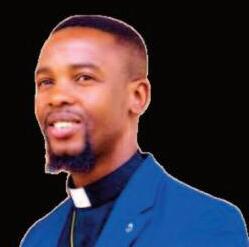
Young people are capable of so many things in life; they are well advanced and a lot of information is available to them, more than it was to many of us They are rich in Godgiven gifts They have dreams; big dreams. There is a lot of untapped goodness in young people
It is a challenge to accompany young people in their world of self-discovery In their world of many possibilities, they do not necessarily need us to teach them, but they need us to accompany them to be fathers and friends to them, and teachers when all seems to be confusing to them Being to them a home that welcomes, a school that teaches, a church that connects them to God, and a playground that will allow them to be free and express themselves to you. Young people need us.
The multicultural community of Utume in Kenya taught me to be missionary at heart, all the time. No matter how challenging life may be, never be judgmental of your fellow person God’s image should always be shining in all the people we encounter If I’m not able to see God in the face of my confrere or any other person, I may not be able to see God at all The mystery of incarnation should teach us on how to relate with each other. “So that they may be one ”
I wished to be like Don Bosco, a simple priestF r X o l i l e G a l a t a w a l k s w i t h y o u n g p e o p l e . H e w a s o r d a i n e d a s a S a l e s i a n p r i e s t b y B i s h o p V i c t o r P h a l a n a i n V i l j o e n s k r o o n i n K l e r k s d o r p d i o c e s e i n M a y ,
I know that there are some readers who have regularly made a pilgrimage to this extraordinary little town in the south of France I know there are others who long to, but may never have the opportunity
As I arrived with my recently widowed mother, I noticed that there has been a pattern to my own visits I went three times as a zealous teenager (I was living fairly nearby, in the UK); then again 20 years later as a Jesuit novice; and now 20 years after that as a much older man.

The impact, though, has been the same each time: a sense of stepping out of the ordinary world into a place which is as close to heaven on earth as we might expect to see On the surface this might seem to be because of the beautiful churches basilica built on top of basilica, reflecting different styles of architecture and hosting magnificent religious art
Or it might be because of the serenity of being in the midst of tens of thousands of people of all nations praying side by side It is partly the gorgeous setting, with the Pyrenean mountains all around and the fast-flowing river Gave de Pau right next to the grotto. And this is all enhanced by the presence of seemingly millions of candles burning everywhere.
But for me, the real reason that this is heaven on earth is because it completely overturns the priorities of the world. Here it is not the rich or the powerful or the well-connected who are the priority It is the weak, the disabled, the elderly, the sick.
Priority is not given to the BMW or the car with the flashing blue lights, but to the simple wheelchair or the rickshaw being pulled by keen young volunteers Even the priests and bishops seem to conduct themselves with more humility in Lourdes (not something I have ever noticed in Rome!)
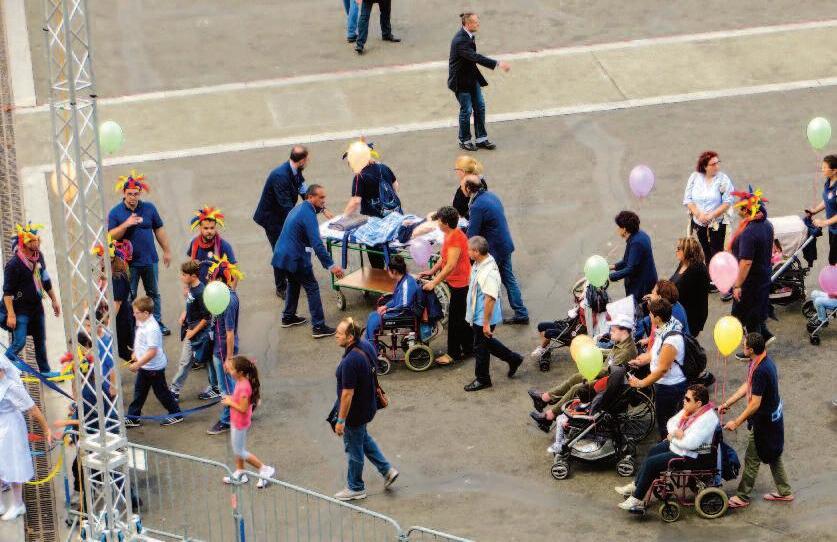
Readers may recall a catchy modern hymn with the refrain, “And the new life you give, is what’s turning the world upside down” The reference is to Isaiah 24:1, but more so to Acts 17:6 where it is used as an accusation against Paul and Silas by the people of Thessalonica for having disturbed their nice orderly city (and their nice comfortable lives).
That is what the Gospel of Christ does it turns the world upside down And if Christ has not turned your per-
sonal world upside down, then you may do well to read the Gospel more closely Lourdes draws so many pilgrims because of Mar y’s appearance 165 years ago to an impoverished, illiterate 14year-old shepherdess. Mar y’s choice of Bernadette Soubirous and similarly unlikely candidates at her appearances in Fatima, Medjugorje and other sites is clearly an echo of the canticle that Luke has Mar y proclaim at the beginning of his Gospel: “He has set down the mighty from their thrones and raised up the lowly ”
Because of the tradition of miracles of healing, Lourdes is especially a draw to people suffering from all kinds of physical ailments, and that is why the whole place is designed to accommodate those wheelchairs Long before the rest of the world noticed the importance of this and South Africa is still shamefully behind Lourdes had embraced the principle of being accessible
By contrast, I recall a religious order in South Africa which had spent a fortune on a very fancy new pastoral centre and had completely ignored the needs of wheelchair users in designing it One afternoon spent by the superior with an opinionated friend of mine with a disability prompted him to retrospectively make the necessary alterations.
But it is not just the physical ways in which Lourdes welcomes everyone; it is also the attitudes of ever yone there.
This means that even if someone is suffering from the most physically awkward or ugly condition, they know that they are welcome not only in the churches but also in the bars and hotels that surround them.
But why do we have to go to Lourdes to experience this? We pray ever y day that the Father’s will be done “on earth as it is in heaven” Is it only in a special pilgrimage site thousands of kilometres away that we can show the world what heaven on earth might look like? Of course not We have a chance in ever y one of our parishes, if only we have the will to prioritise this.
However, sadly we do not SA Sign Language has just been declared our 12th official language and we are used to seeing signing on TV, at national events and even at the theatre But have you ever seen signing at Mass?
I once asked a bishop why not a single one of the dozen churches in the centre of his major city offered a regular Sunday Mass with sign interpretation And his answer was: “Well, it’s not needed, because deaf people don’t come to church ” He seemed oblivious to the idea that deaf people were not coming because they would not be able to follow what was happening, or that deaf Catholics were instead going to other churches which were more welcoming
So let me offer the start of a checklist which ever y parish can consider if we want to fulfil Pope Francis’ words: “That the Church should be the place that welcomes everyone and refuses no one.”
• Do you (in collaboration with other parishes in the area) offer a regular sign-interpreted Mass?
• Do you use a projector to show every part of the Mass so that someone who cannot hear well can participate fully?
• Do you have an induction loop to assist people with hearing aids?
• Is your church (and your toilet) accessible to people in wheelchairs?
• Do people in wheelchairs have a “place of honour” in the church, or are they shunted off to the side or made to feel awkward?
• Has a blind or poorly-sighted person advised you on how to remove inadvertent obstacles in your church and surrounding precinct?
• Is your congregation welcoming to people with learning difficulties, no matter how they behave or what sounds they might make?
• Does your church take the trouble to understand the needs of families with young children?
• Do you have a system for collecting those who lack transport so they can come to church, especially the elderly?
• Do you distribute Communion in a way that ensures that ever yone can participate and noone feels like an afterthought?
• Do you think about the needs of those who have poor eyesight in printing the bulletin and other notices?
• Is there someone on your parish pastoral council who has a disability and who can voice the needs of people with disabilities?
None of this is rocket science. Very little of it is expensive to implement It is mostly about noticing the needs of others and prioritising those which after all is what the Gospel challenges us to do The rest of society may not do this but that is why our Christian witness can be so powerful.
As a deaf priest and friend of mine once said: “It is not my ears that disable me; it is the thoughtless behaviour and attitudes of others that disable me ” Let’s turn the world upside down!
FOR TOO MANY YEARS, FOR ME, Christ was simply Jesus’ last name: Jack Smith, Susan Parker, Jesus Christ Intellectually, I knew better; but practically, both in my private faith and as a theologian, I functioned as if Christ were simply Jesus’ surname. Whether in prayer, writing or preaching, I almost always used the two names together, Jesus Christ, as if there were a perfect identity between the two
There’s not Jesus is a divine person inside the Trinity, someone who once walked this earth as a flesh and blood individual and who now is with the Father as part of the Godhead And although he is also the key component inside the reality of Christ, Christ is more than Jesus
Christ is a mystery which also includes us, Jesus’ followers on earth, the sacraments, the Word (Scripture), and the Church Scripture is clear: We are the Body of Christ on Earth We don’t represent Christ, replace Christ, or are some vague mystical presence of Christ We are the Body of Christ, as too are the Eucharist and the Word (the Christian Scriptures).
That distinction has huge implications, both for our private faith and for how we live out our faith in the Church To simply identify Jesus and Christ impoverishes our discipleship, irrespective of which name (Jesus or Christ) we most relate to M
Let me begin with a mea culpa: In living out my faith, I more easily and existentially relate to Christ than to Jesus. What that means is that I have a belief in and a lifelong commitment to the reality of the resurrection, to Jesus’ teaching, to the Church, to the sacraments, and to the Christian scriptures I believe that participation in the Eucharist is the single most important thing I do in life, that the Sermon on the Mount is the greatest moral code ever written, and that the Church, despite all its faults, is the Body of Christ on Earth
But, unlike many of the faith-filled mystics and saints that I read, and unlike many of my Evangelical friends and colleagues, I struggle to have a real sense that Jesus is an intimate friend and lover I struggle to be the beloved disciple in John’s Gospel who has his head reclining on the breast of Jesus and for whom oneto-one intimacy with Jesus relativises everything else
I know that Jesus is real and wants a deep one-to-one intimacy with each of us; but truth be told, I struggle to actually feel that most days and to make it the central
part of my discipleship Commitment to the Eucharist, Jesus’ teaching, and the Church are, save for graced affective moments in prayer, the heart of my faith and lived discipleship Habitually I relate more to Christ than to Jesus
And, let me risk adding this: I believe that is also true for various Christian churches We have churches that relate more to Christ and churches that relate more to Jesus (not that either excludes the other) For example, my own Church, Roman Catholic, is a very Christ-centred church Ecclesial community, Eucharist, the sacraments, and Jesus’ teachings are key R e l a t i o n s h i p s t o J e s u s
No true Catholic can ever say that all I need is a private relationship to Jesus That is also true of most Anglicans and other mainline Protestants It is less true for churches within the Evangelical family, where the salient mandate in the Gospel of John to have an intimate relationship to Jesus more easily becomes the central tenet within Christian discipleship.
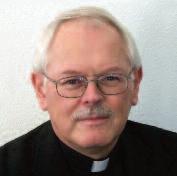
It is not that the different churches exclude the other dimension For example, Catholicism, Anglicanism, and mainline Protestantism emphasise private prayer as a means to relate to the person of Jesus as an intimate friend and lover To this, Catholicism brings its rich (sometimes overrich) tradition of devotional prayer Conversely, Evangelicals, with their strong focus on Jesus, use communal services of the Word and preaching as their major way to relate to the wider mystery of Christ
We have something to learn from each other. Churches, just as individuals, must be about both, Jesus and Christ, that is, focused on a personal relationship with Jesus and participation in the historical incarnational mystery of Christ, of which each of us is part We must be focused on Jesus, but also on the Eucharist, the Word, and the community of believers each of which is the Body of Christ
Our faith and discipleship must be both deeply private and visibly communal No Christian can legitimately say, “My discipleship consists wholly in a private relationship to Jesus”, just as no Christian can legitimately say, “I don’t need Jesus, I need only church and the sacraments”
We are disciples of Jesus Christ, both the person and the mystery We are committed to a set of teachings, a set of scriptures, the Eucharist, and to a visible community we call the Church as well as we are committed to a person named Jesus who is the heart of this great mystery and who wants to be our friend and lover
Every month Fr chris chatteris SJ reflects on Pope Francis’ prayer intention
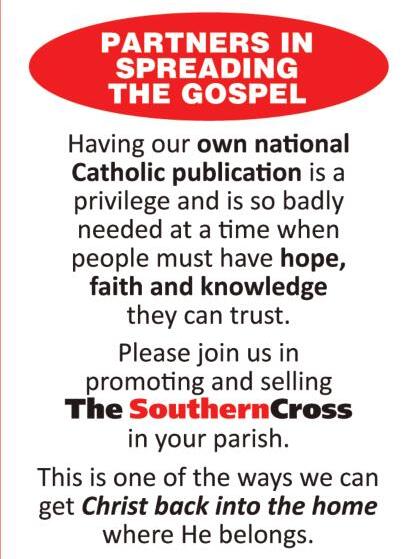

Intention: We pray for the Church, that she may adopt listening and dialogue as a lifestyle at every level, and allow herself to be guided by the Holy Spirit towards the peripheries of the world
ON MY ANNUAL RETREAT, m a d e w i t h a g r o u p o f f e l l o w J e s u i t s , t h e r e w a s a d a i l y s e ss i o n o f w h a t w e d e s c r i b e a s “ s p i r i t u a l c o n v e r s a t i o n ” T h i s i s a w o nd e r f u l l y l i b e r a t i n g e x e rc i s e i n t h e s p i r i t o f s y n o d a l i t y. S o m a n y o f o u r c o n v e r s a t i o n s a r e c h a r a c t e r i s e d b y t h e c u t a n d t h r u s t o f a r g u m e n t . I n t h e o r y, a r g u m e n t a n d d eb a t e l e a d t o t h e t r u t h ; i n p r a c t i c e w e k n o w t h a t o u r l o w e r m o t i v e s , s u c h a s scoring points against one another, can f a t a l l y s u b v e r t t h e s e a rc h f o r t r u t h I t i s l o s t i n t h e p r i d echarged desire to come out on top i n t h e b a t t l e o f w i t s S p i r i t u a l c o n v e r s a t i o n , b y c o n t r a s t , l a y s a s i d e t h e w e a p o n s of the wit-war and takes up the tools of a c t i v e l i s t e n i n g S h a r i n g t h e i n s i g h t s a n d c o n s o l a t i o n s o f o n e ’s p r a y e r a n d r e f l e c t i o n o n a p a r t i c u l a r t o p i c o r i s s u e w i t h o u t t h e d a n g e r o f b e i n g s h o t

d o w n o r t a k e n t o t a s k e n a b l e s o n e t o b r o a c h t h e s u b j e c t a t a c e r t a i n d e p t h . Being confident that what one says will b e l i s t e n e d t o w i t h r e s p e c t a n d i n a p r a y e r f u l a t m o s p h e r e e m p o w e r s a p e rs o n t o s p e a k f r o m t h e h e a r t a s w e l l a s t h e h e a d .
‘ T a l k - t i m e ’ d o m i n a t o r s W h a t I c a l l “ t a l k - t i m e ” i s a n o t h e r b e s e t t i n g p r o b l e m o f o r d i n a r y, e v e r yday argument So often the most dominant character devours the lion’s share
get their considered opinions heard S o m e t i m e s i t ’s t h e l o u d e s t m o u t h a n d e m p t i e s t h e a d t h a t c a r r i e s t h e d a y a n d w i s e r c o u n s e l i s s m o t h e r e d a n d m a r g i n a l i s e d M i g h t i s r i g h t a n d t h e v e r b a l P u t i n s p r e v a i l !
of the talk-time, so much so that others h a r d l y g e t a w o r d i n e d g e w a y s A p a r t f r o m t h i s b e i n g u n j u s t t o t h e l e s s a ss e r t i v e , i t m e a n s t h a t t h e q u i e t e r a n d perhaps more thoughtful people do not
We join countless others in congratulating c A r D i n A l S t E p h E n b r i S l i n on his elevation to the College of Cardinals We assure him of our prayers as he begins his ministry to the worldwide church, especially to those who find themselves on the margins of life.
Catholic Parliamentary Liaison Office Website: www.cplo.org.za

T h e s p i r i t u a l c o n v e r s a t i o n Spiritual conversation, by contrast, h a s a s t r u c t u r e o f f a i r n e s s a n d d i v i n e c h a r i t y b u i l t i n t o i t I n e a c h r o u n d o f s h a r i n g , e v e r y i n d i v i d u a l h a s a n e q u a l “ r a t i o n ” o f t a l k - t i m e I t ’s n o t o b l i g at o r y t o u s e i t a l l b u t n e i t h e r c a n you run over your limit And after e a c h i n t e r v e n t i o n , t h e r e i s a r es p e c t f u l m o m e n t o f s i l e n c e d u ri n g w h i c h t h e p e r s o n ’s w o r d s a r e a l l o w e d t o s i n k i n , a s p a c e f o r t h e “ s t i l l s m a l l v o i c e ” o f t h e S p i r i t
A s t h e p r o c e s s c o n t i n u e s t h e s t r u ct u r e c a n b e r e l a x e d a l i t t l e t o a l l o w f o r m o r e s p o n t a n e i t y, b u t t h e g e n e r a l r u l e a p p l i e s t h a t w e a r e n o t o u t t o s h o o t d o w n w h a t o t h e r s s a y b u t t o l i s t e n o u t f o r t h e H o l y S p i r i t i n t h e i r w o r d s
A p a r t f r o m b e i n g a b l e t o g o m o r e d e e p l y i n t o t h e m a t t e r a t h a n d a n d b e i n g o n a s u r e r p a t h t o w h a t i s g o o d a n d t r u t h f u l , t h i s w a y o f p r o c e e d i n g has the positive side effect of building up the community of interlocutors and s t r e n g t h e n i n g t h e b o n d s b e t w e e n them In a small way, I think that even the Jesuits, argumentative and opiniona t e d l o t t h a t w e a r e , c a n b e n e f i t f r o m the synodal vision of Pope Francis SJ! A s y n o d i s a l a r g e a n d l o v i n g s p i r it u a l c o n v e r s a t i o n L e t u s p r a y a n d g i v e t h a n k s f o r t h e s y n o d a l C h u rc h t o w h i c h w e b e l o n g
The first session of the Synod on Syno d a l i t y w i l l b e h e l d i n R o m e f r o m O c t o b e r 4 - 2 9 T h e s e c o n d a n d f i n a l s y n o d o n t h e s u b j e c t w i l l m e e t i n Rome in October 2024
Sometimes it’s the loudest mouth and emptiest head that carries the day
LOVING GOD AND FATHER, I kneel in fear before Your Powerful Majesty, fearing this self, not trusting my fragile faith, ever fearing I will betray you because of my sinful nature and utter selfishness And therefore, Loving Father, I seek refuge in the Heart of Your beloved Son, Jesus I implore that even one spark from His Sacred Heart may set my sinful heart ablaze with a deeper love for You and for all that is holy Permit me a deeper relationship with Him, and a consecration to His most Sacred Heart. I offer my total person, my life and every action, pain and suffering, so that I may no longer be willing to use any part of my being except to honour, love and glorify the Sacred Heart; to be all His and to do all for love of Him.
I also renounce whatever can displease Him or displease Your holy will. I therefore take You, Sacred Heart of Jesus, as the object of my love, the protector of my life, the pledge of my salvation, the remedy for my weakness and the secure refuge at the hour of my death. I surrender this prayer humbly to Your infinite love, patience and mercy in the name of Jesus, Your divine Son, Amen
By Fr Ralph de HahnOur Lady of the Rosary, you care for each of us with tender motherly love. You wish us to truly turn to you so that you may care for us as a mother. Please bring all of our needs before the throne of your Divine Son, and we particularly ask today that you pray that we and all people may grow in true devotion to you!
Amen
Do you have a favourite prayer? Please send it to editor@scross co za
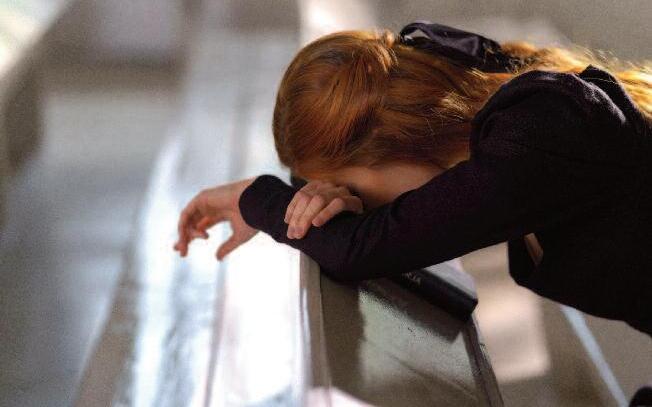

St John XXIII, your simple and meek persona carried the scent of God and the desire of goodness was inflamed in your hear t. Pray for us so that we do not limit ourselves to mourn the darkness but rather to enkind le the light, bringing Christ ever ywhere and always, Amen


We stand before You, holy Spirit, as we gather together in Your name With You alone to guide us, make Yourself at home in our hearts; teach us the way we must go and how we are to pursue it. We are weak and sinful; do not let us promote disorder. Do not let ignorance lead us down the wrong path nor partiality influence our actions. let us find in You our unity so that we may journey together to eternal life and not stray from the way of truth and what is right. All this we ask of You, who are at work in every place and time, in the communion of the Father and the Son, forever and ever.
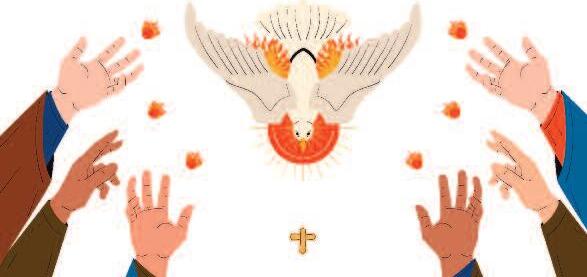
Amen


Unscramble the clues below to work out which SACBC


hide in these words
AcroSS
3 The priest not in charge (9)
8 Colours of the manuscript illuminator (4)
9 Mothers or Fathers in the cloister (9)
10. You will get a delivery from here in church (6)
11 A continental person (5)
14 His wife got to salt to play the game (5)
15 Won’t work (4)
16 Girl who’s a changed Roman (5)
18. About once there may be an ice-cream in it (4)
20 Spoilt sacrificial offering? (5)
21 An evil person did not stand an addition (5)
24 Confused creator loses a head of college (6)
25. Shows the door (5,4)
26 System of canon law (4)
27 Like a sick person with unpicked flowers in the garden (9)
DoWn
1 Put in the wrong spot (9)
2 They may be concealed in your cupboard (9)
4 Close (4)
5 Articles that change times (5)
6 Like the relationship between sons of Jacob (6)
7 Ointment at the end of spike (4)
9. The simple saint? (5)
11 First high priest of Israel (5)
12. An account provided by the reader (9)
13 Rosary obscurities? (9)
17 Religious home (5)
19 One paid for work (6)
22 Give the prize (5)
23 New Testament letter (4)
24 Not very often (4)
For all solutions turn to page 34
AcroSS
2. Finder of the True Cross (6)

3 Esau’s brother (5)
4. Mary, Untier of .... (5)

5 Book for liturgy (6)
6. Coffee named after Franciscans (9)
7 Southern Cross columnist Grazia (8)
8. Eswatini diocese (7)
9 Part of priest ’s vestments (5)
10. Pauline epistle (9)

14 ‘Bind and ’ (5)
15 Irish Marian shrine (5)
16 Jesuit saint Peter (6)
17 Delivering a homily (9)
18 Ten religious laws (12)
19 Head of female religious community (6)
20 Durban’s auxiliary bishop Elias (5)
21 Diocesan administrator (5,7)

22 St John Paul II’s Polish city (6)
23. Town of St Therese (7)
24. Site of Dead Sea Scrolls (6) DoWn
1. TV Series on Jesus’ disciples (3,6)
2. Messenger of God (5)
3 Country of Our Lady of Kibeho (6)
4 Jacob’s hirsute brother (5)
5 Sistine Chapel artist (12)
6 Talk with God (4)
7 Arabic for God (5)
8 Sung Mass (5,7)
9 Catholic gymnastics champ (6,5)
1. What was the family name of St Francis of Assisi?

a) Bernadone b) Forgione
c) Offreduccio
2. In which Italian region is Assisi located?
a) Lazio b) Tuscany c) Umbria
3. What career did St Francis’ parents envisage for their son?
a) Businessman b) Politician c) Soldier
4 Why did Francis spend at least two weeks in Nor th Africa?
a) He wanted to convert the Sultan
b) He wanted to negotiate a peace treaty
c) He wanted martyrdom
5 Why did St Clare have a strained
relationship with the pope?
a) Pope didn’t like her personality
b) She was too bossy
c) She was too rigid on poverty
6. Who was Ber nard of Quintavalle?
a) Archbishop of Assisi
b) Cardinal who supported Francis
c) Francis’ first follower
7 Which animal did St Francis tame at Gubbio?
a) Bear b) Lion c) Wolf
8. What did St Francis do at Greccio?
a) Invent the Nativity Scene
b) Speak to the birds
c) Write the Franciscan Rule
9 Which sister of St Clare also

11 Hebrew for ‘Praise the Lord’ (8)
12. Catholic author JRR (7)
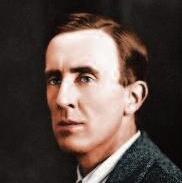
13 Portugal’s Euch Miracle town (8)
16 Liturgical colour (5)
17 Postnominal for Redemptorists (4)
18 Make reparation for sin (5)
19. Bishops’ Rome visit (2,6)
21 Easter proclamation (8)
22 Latin for Cross (4)
became a nun and a saint?
a) Agnes b) Barbara c) Catherine
10 Which South African diocese has cur rently a Franciscan bishop?

a) Durban b) Kokstad c) Port Elizabeth
• With additional questions by Fr Paddy Noonan O
E v e r y m o n t h i n h e r C a p e T o w n k i t c h e n , G R A Z I A B A R L E T T A p r e p a r e s a r e c i p e i n s p i r e d b y t h e s a i n t s , a n d s h a r e s i t w i t h o u r r e a d e r s i n t e x t a n d p h o t o s t a k e n e x c l u s i v e l y f o r T h e S o u t h e r n C r o s s b y t h e c h e f h e r s e l f .
TH I S M O N T H ’ S R E C I P E I S I N S P I R E D by the 14th-century saint Roch (also known as St Rocco, Rock or Roque), a nobleman from Montpellier, France
The only son of the wealthy governor of the city, Roch was born with an unusual red mark on his chest in the shape of a cross This was seen as an answer to his mother ’s prayers for her infertility to be healed
After his parents died when he was 20, Roch gave his inheritance to the poor and began a new life of a poor mendicant pilgrim as a Third Order Franciscan
On a pilgrimage to Rome, Roch came upon the town of Acquapendente, near Viterbo, which was badly struck by the black plague He remained there for a time to care for the sick at significant risk to himself He cured many people simply by making the Sign of the Cross over them His miraculous healing continued in every plague-infested town that he passed through, and in Rome itself
But in the town of Piacenza, the plague caught up with him Instead of burdening anyone with his sickness, he commended himself to God and awaited his death in a remote forest hut Therea local nobleman’s hunting dog found him, bringing him food daily and licking his wounds One day, the nobleman followed his dog into the woods, which led him to discover and nurse the holy pilgrim back to health
Returning to Montpellier, Roch found the city at war and was cast into prison as a suspected spy by his own uncle, the gover-
nor, who failed to recognise his nephew When he felt that his end was drawing near, St Roch requested the last sacraments As he died, a tablet appeared on the wall on which an angelic hand wrote his name in golden letters, and the prediction that all who would invoke his intercession would be delivered from the plague
St Roch is the patron saint of dogs and their owners, contagious diseases, pestilence and epidemics, knee problems, surgeons, invalids, bachelors, and diseased cattle His feast day is on August 16

The story of St Roch and the dog resonates with me: I am the owner of the quirkiest Shih Tzu puppy with the big gest personality Oscar brings me so much joy, and he loves eating just like an Italian would

The term semi freddo is Italian for halfcold It ’s a class of frozen desserts similar to
300ml whipping cream • 4 large eggs, separated • 60ml Amaretto or coffee liqueur




• 1 packet Amaretti biscuits, crushed
ice cream This recipe is so appropriate; dogs love licking us, and we love licking delicious ice-cream, or in this case semi freddo What better way than this dessert to remember St Roch and the dog? It is easy to make; you can add any other ingredients such as chopped hazelnuts or dark chocolate to the mixture
Servings: 8-10 • preparation: 30 minutes and freezing time
1. Whip the cream until thick. Beat sugar and egg yolks until pale and creamy Beat egg whites until a stiff peak forms


2. Stir biscuits and liqueur into the egg yolk Then fold in cream and egg whites
3 Pour into a freezer-container or large dish Freeze for a few hours, then serve Best made the day before serving it
5 Enjoy with a prayer to St Roch!
fo o d p h o to g ra p h e r & st y l i st S h e ca n b e co nta c te d at g ra z i a b a r l e tta 1 @ g m a i l c o m Fo l l o w h e r b l o g at w w w m o m e nt s w i t h g ra z i a c o m a n d co n n e c t w i t h G ra z i a o n Fa c e b o o k / I n sta g ra m : m o m e nt s w i t h g ra z i a
Southe tant, 8 Inks, 9 Superiors, 10 Pulpit, 11 Asian, 14 Lotto, 15 Lazy, 16 Norma, 18 Cone, 20 Burnt, 21 Satan, 24 Rector, 25 Turns away, 26 Code, 27 Bedridden DOWN: 1 Misplace, 2 Skeletons, 4 Shut, 5 Items, 6 Tribal, 7 Nard, 9 Simon, 11 Aaron, 12 Narration, 13 Mysteries, 17 Abbey, 19 Earner, 22 Award, 23 Jude, 24 Rare
Anagram Challenge: 1 Port Elizabeth, 2 Polokwane, 3 Francistown, 4 Cape Town, 5 Bloemfontein, 6 Rustenburg
Dropped Letters: Synodality, New Evangelisation, Eucharist, Word of God, Family, Africa, Young People, Consecrated Life

Quick Crossword: ACROSS: 2 Helena, 3 Jacob, 4 Knots, 5 Missal, 6 Cappuccino, 7 Barletta, 8 Manzini, 9 Stole, 10 Galatians, 14 Loose, 15 Knock, 16 Claver, 17 Preaching, 18 Commandments, 19 Abbess, 20 Zondi, 21 Vicar General, 22 Krakow, 23 Lisieux, 24 Qumran DOWN: 1 The Chosen, 2 Angel, 3 Rwanda, 4 Esau, 5 Michelangelo, 6 Pray, 7 Allah, 8 Missa Cantata, 9 Simone Biles, 11 Alleluia, 12 Tolkien, 13 Santarem, 16 Green, 17 CSsR, 18 Atone, 19 Ad Limina, 21 Exsultet, 22 Crux St Francis Trivia Quiz: 1 a) Bernadone, 2 c) Umbria, 3 a) Businessman (to follow his father in his textile business), 4 c) He wanted martyrdom, 5 c) She was too rigid on poverty, 6 c) Francis’ first follower, 7 c) Wolf, 8 a) Invent the Nativity Scene, 9 a) Agnes, 10 c) Port Elizabeth (Bishop Vincent Zungu)

Spiritual Director Mgr Simon Donnelly of Johannesburg, formerly based in the Vatican

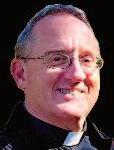

Guided in the Holy Land by Gabriel Makhlouf Expert guide and Catholic Knight of the Holy Sepulchre

Accompanied by Günther Simmermacher Southern Cross editor and author of The Holy Land Trek
20 May to 1 June 2024







W h a t w e w i l l e x p e r i e n c e :
m , s a i l o n t h e S e a o f G a l i l e e , r e n e w w e d d i n g v o w s a t C a n a a n d b a p t i s m a l v o w s a t t h e R i v e r J o rd a n , f l o a t i n t h e D e a d S e a a n d m u c h m o r e
T h e P i l g r i m a g e i n c l u d e s :
• All flights ex-Johannesburg
• Accommodation in selected 4-star hotels
• Daily breakfast and dinner
• Daily lunch in selected restaurants in the Holy Land

• Daily Mass in sacred shrines and churches
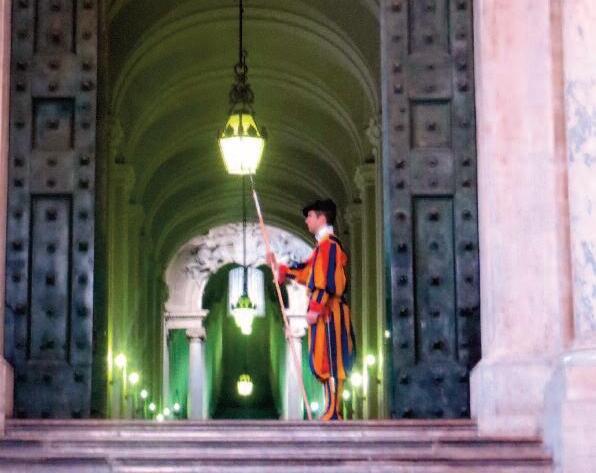

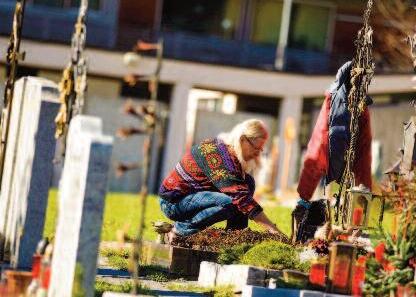
• Travel in air-conditioned luxury buses
• Expertly guided tours throughout

• All entrance fees as per itinerary
• Preparation material
• Visa assistance (where required)
‘The mission of the Christian in the world is a mission for all, a mission of service, which excludes no-one; it requires great generosity and in particular the gaze and heart turned heavenward to invoke the Lord’s help. There is so much need for Christians who bear witness to the Gospel with joy in everyday life. The disciples, sent by Jesus, ‘returned with joy’. When we do this, our heart fills with joy.’
Pope Francis (b 1936)
‘Many, many people are not becoming Christians for one reason only: there is nobody to make them Christians.’
St Francis Xavier (1506-1552)
‘Modern man listens more willingly to witnesses than to teachers, and if he does listen to teachers, it is because they are witnesses.’
– Pope Paul VI (1897-1978)
‘I came to the people of Ireland to preach the Gospel, and to suffer insult from the unbelievers, bearing the reproach of my going abroad and many persecutions even unto bonds, and to give my free birth for the benefit of others ’

St Patrick (4th/5th century)
‘Joy is the net of love by which you can catch souls.’
St Teresa of Kolkata (1910-1997)
‘Your faith will grow only in the measure that you give it away ’ –
Bishop Robert Barron (b 1959)
‘They who want to win the world for Christ must have the courage to come into conflict with it.’
Bl Titus Brandsma (1881-1942)

‘We have been called to heal wounds, to unite what has fallen apart, and to bring home those who have lost their way ’
– St Francis of Assisi (1181-1226)

The great scholar wrote on theology and spirituality, and about his travels around South Africa But his greatest joy was to run the kids page, titled “Children’s Corner” On his travels, he would often meet with the members of the “Children’s Corner”, who wrote to him in great numbers and received unique nicknames in return. One of them was Denis Hurley, the future archbishop of Durban, who received the nickname Robin Mgr Kolbe’s successor as children’s columnist, Granny Dimple (Cecilia Coker), is seated at left She died suddenly in 1939 B o r n i n P a a r l i n 1 8 5 4 , M g r K o l b e w a s t h e s o n o f a C o n g r e g a t i o n a l m i n i s t e r H i s c o n v e r s i o n t o C a t h o l i c i s m i n 1 8 7 7 , f o l l o w i n g a v i s i t t o F r a n c e , c a u s e d h i m t o b e o s t r a c i s e d b y m u c h o f h i s f a m i l y H e w a s o r d a i n e d t o t h e p r i e s t h o o d i n 1 8 8 2 , I n 1 8 9 1 h e f o u n d e d t h e C a t h o l i c M a g a z i n e , a h i g h b r o w p u b l i c a t i o n t h a t r a n u n t i l 1 9 2 5 A s i d e f r o m h i s r e l i g i o u s i n t e r e s t s , M g r K o l b e w a s a l s o a p u b l i s h e d p o e t , a n o t e d a u t h o r i t y o n S h a k e s p e a r e a n d a r e s p e c t e d b o t a n i s t H e w a s t h e r e c i p i e n t o f h o n o r a r y d o c t o r a t e s f r o m t h e U n i v e r s i t i e s o f S o u t h A f r i c a a n d C a p e T o w n . T h e c h a p l a i n c y o f t h e l a t t e r i s n a m e d a f t e r h i m . M g r K o l b e d i e d a t 8
DVatican, a cardinal enters the Blessed Sacrament chapel in St Peter ’s basilica, kneels down before the Body of Christ, beats his chest, and exclaims: “I’m not worthy!”
Another cardinal enters, kneels down
his chest, and exclaims: I m not worthy!”
A third cardinal enters, kneels next to the other two cardinals, beats his chest, and exclaims: “I’m not worthy!”
Whispers the first cardinal to the second: “Oh, look who thinks he’s not worthy!”
tel: 017 826 0054/5 cell: 082





